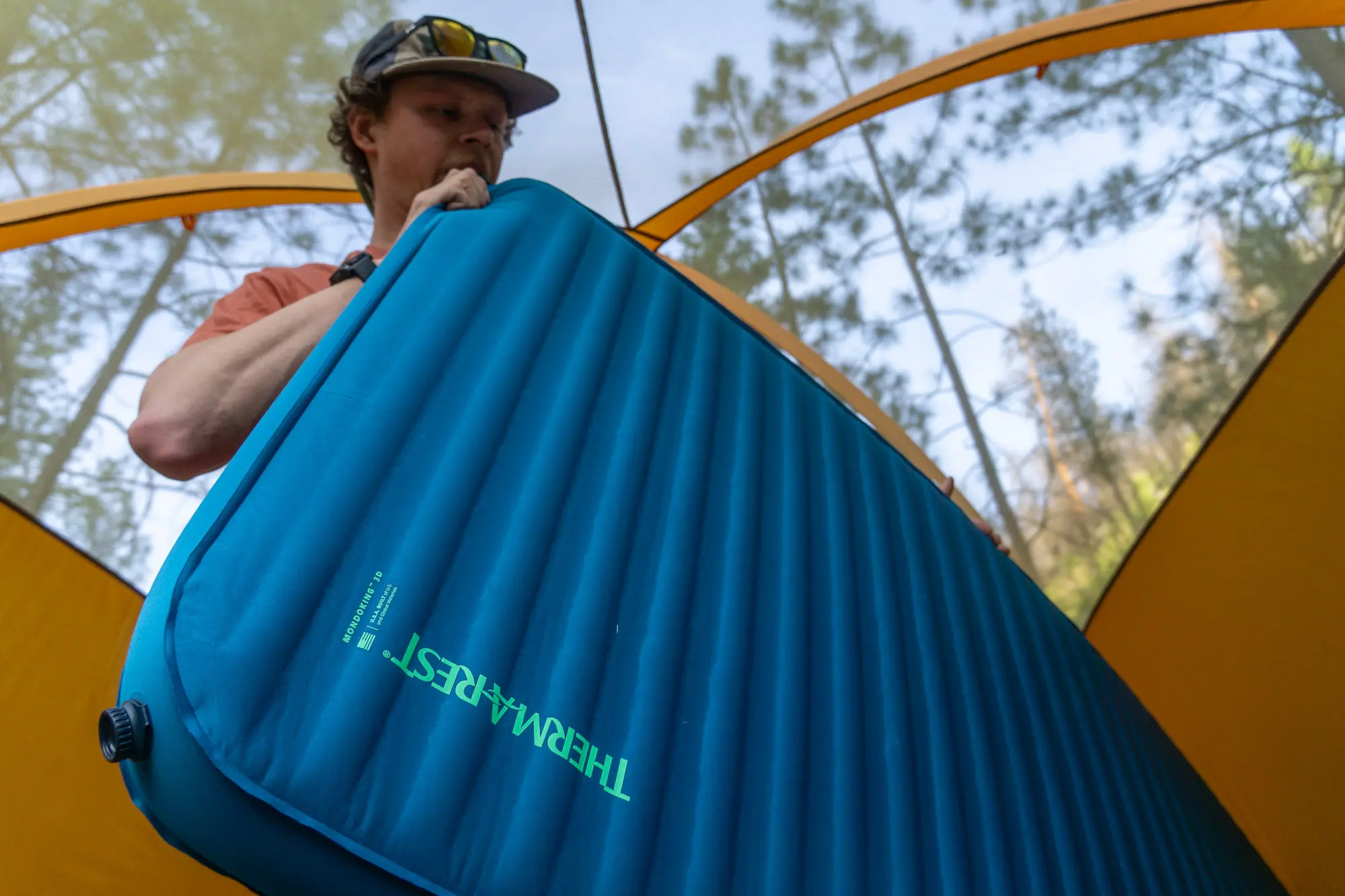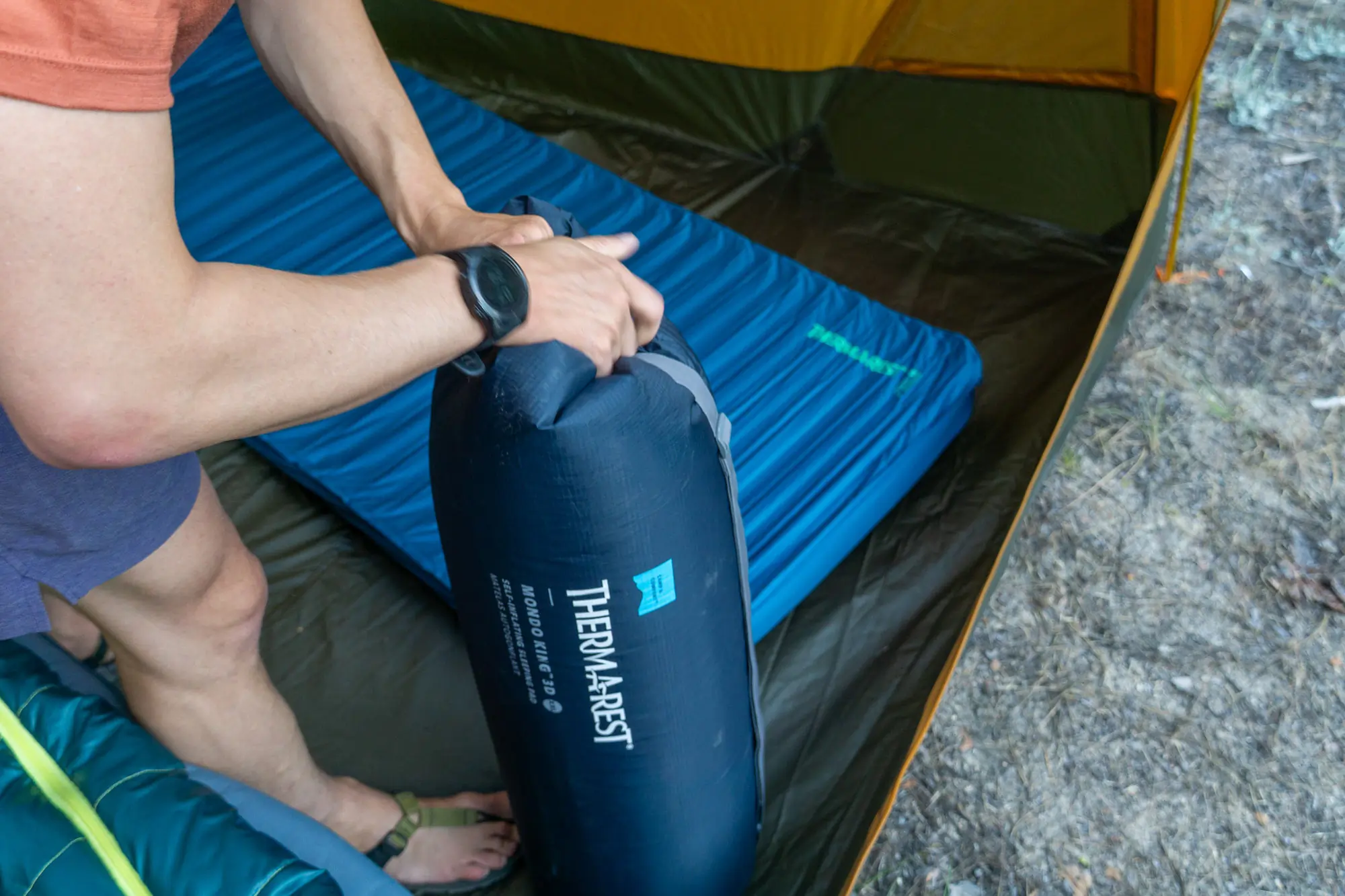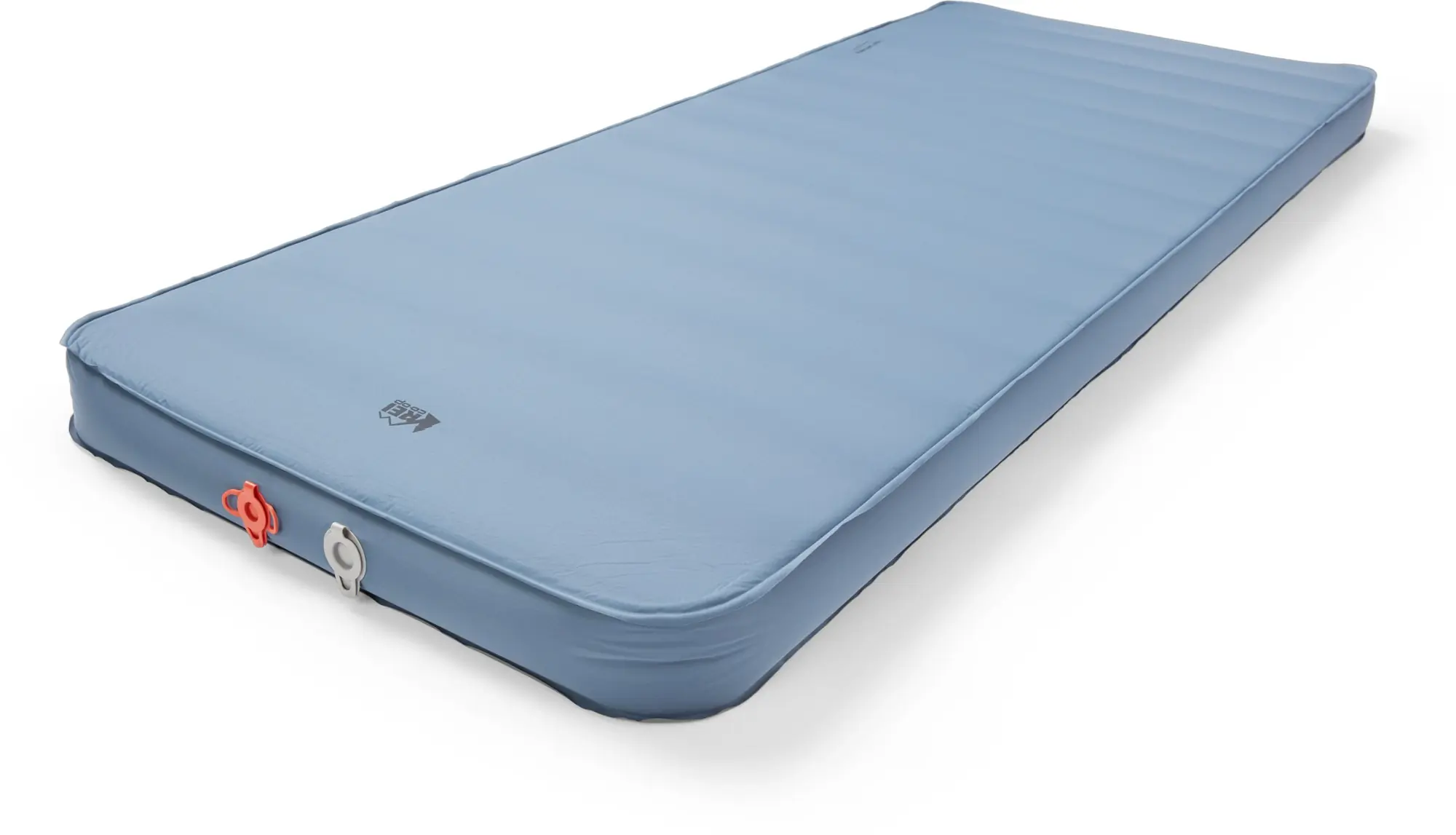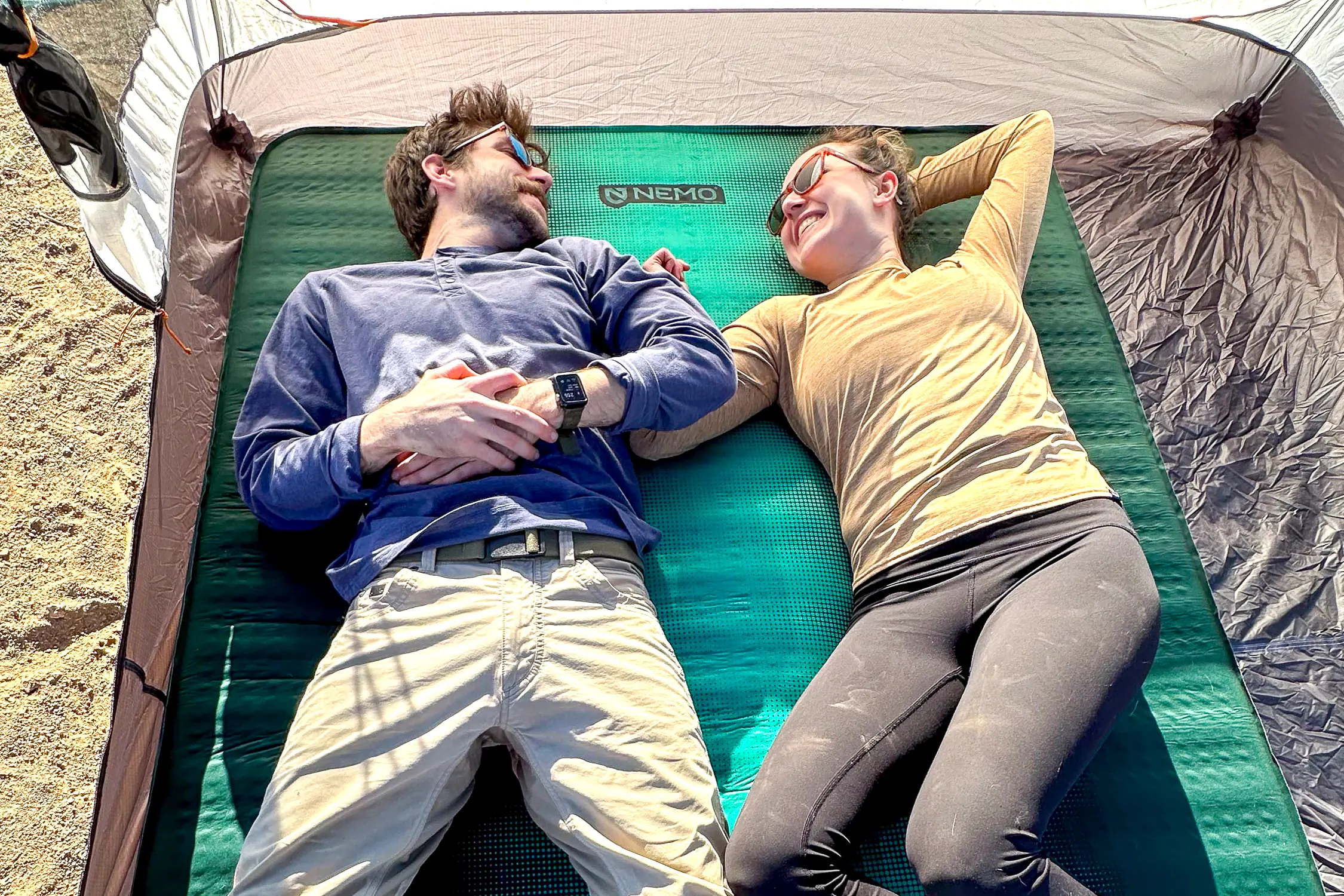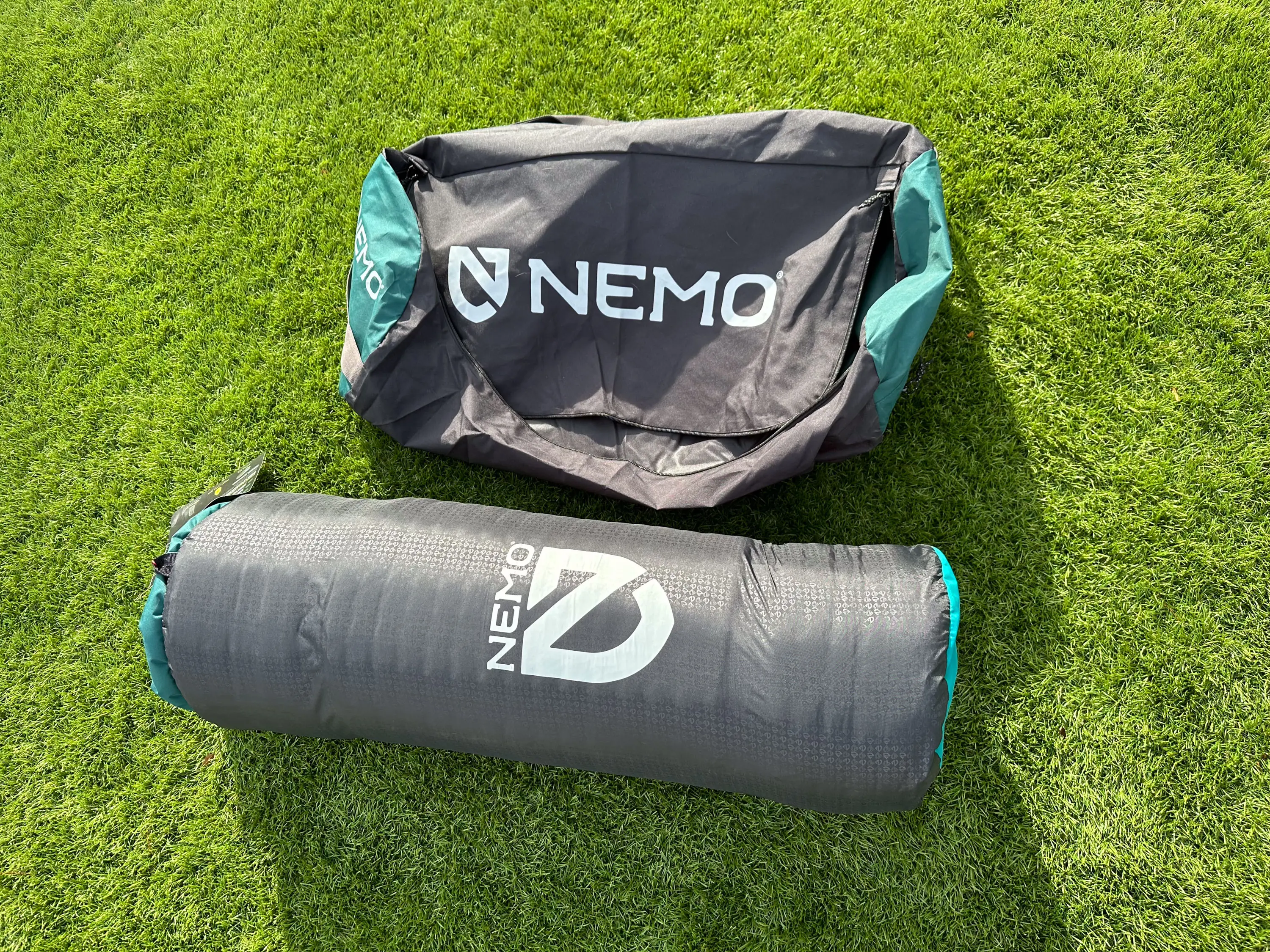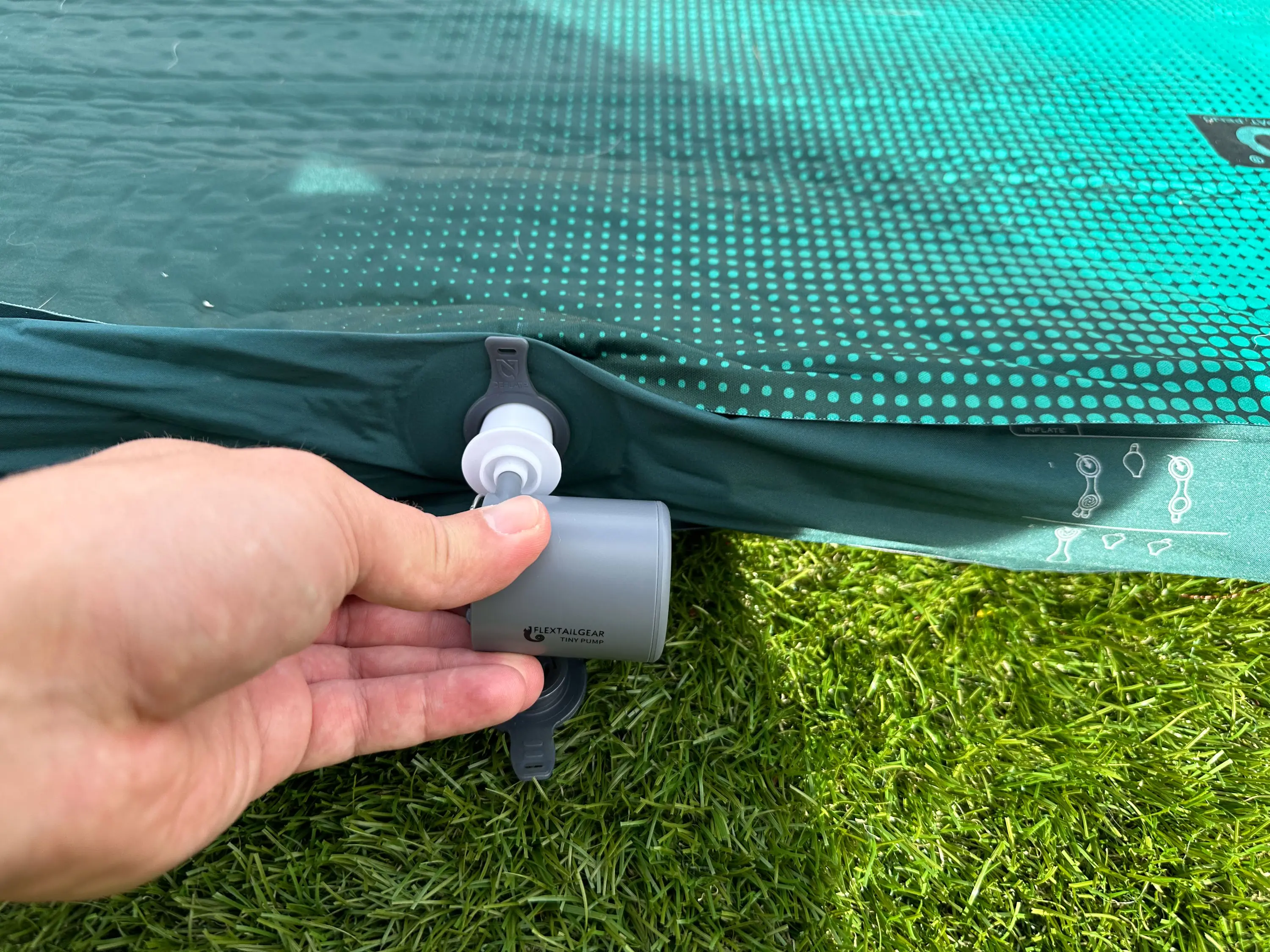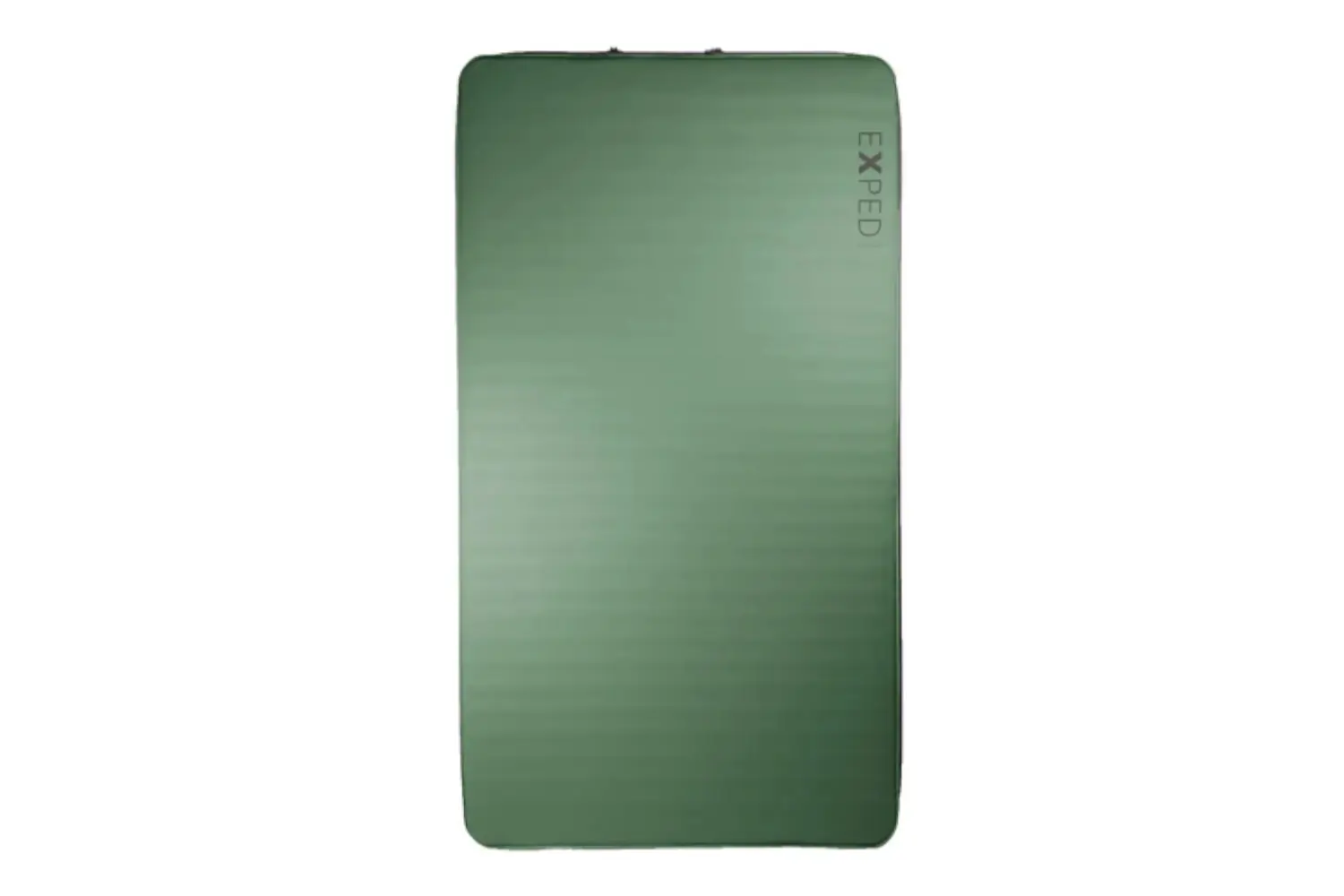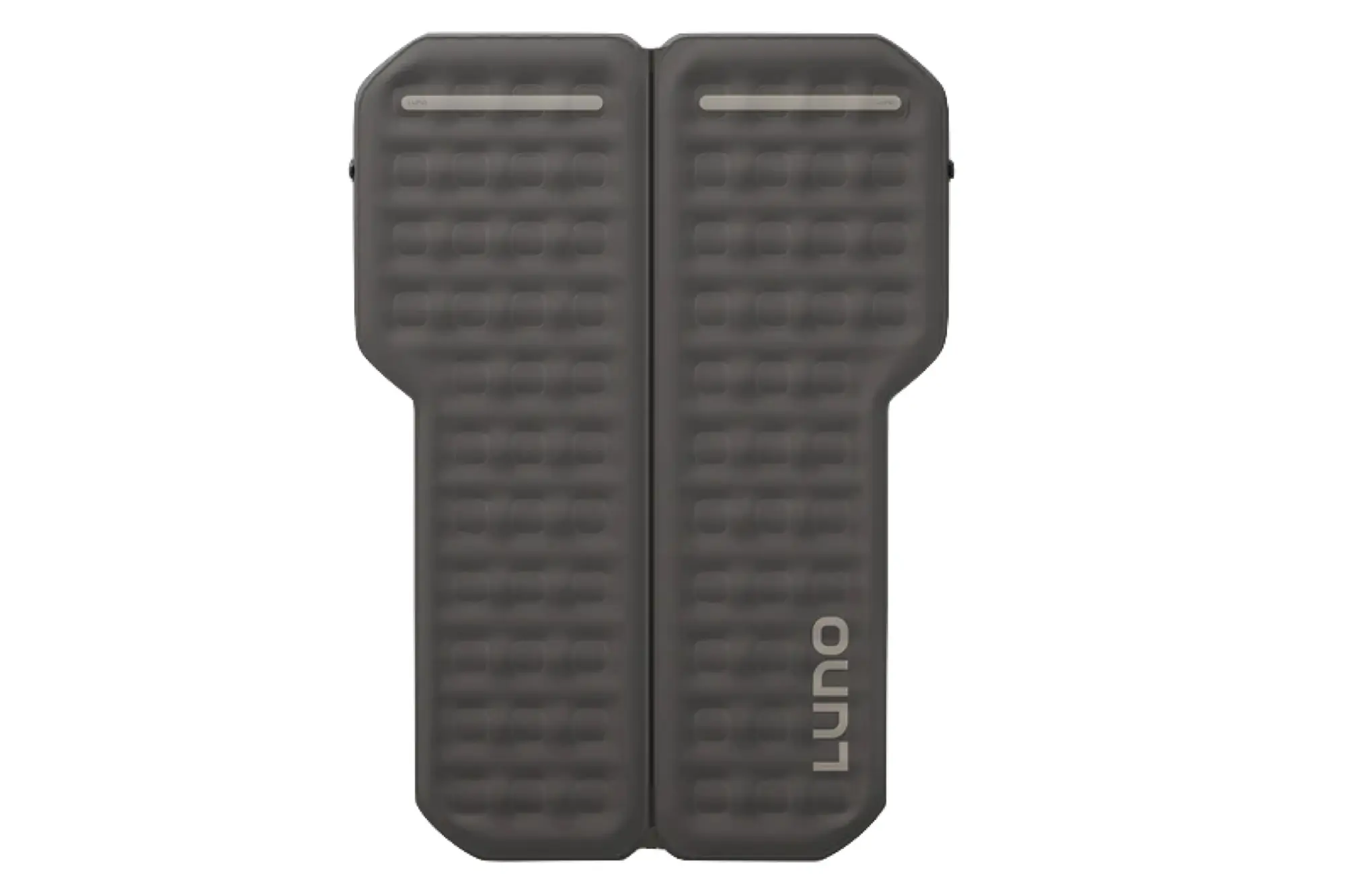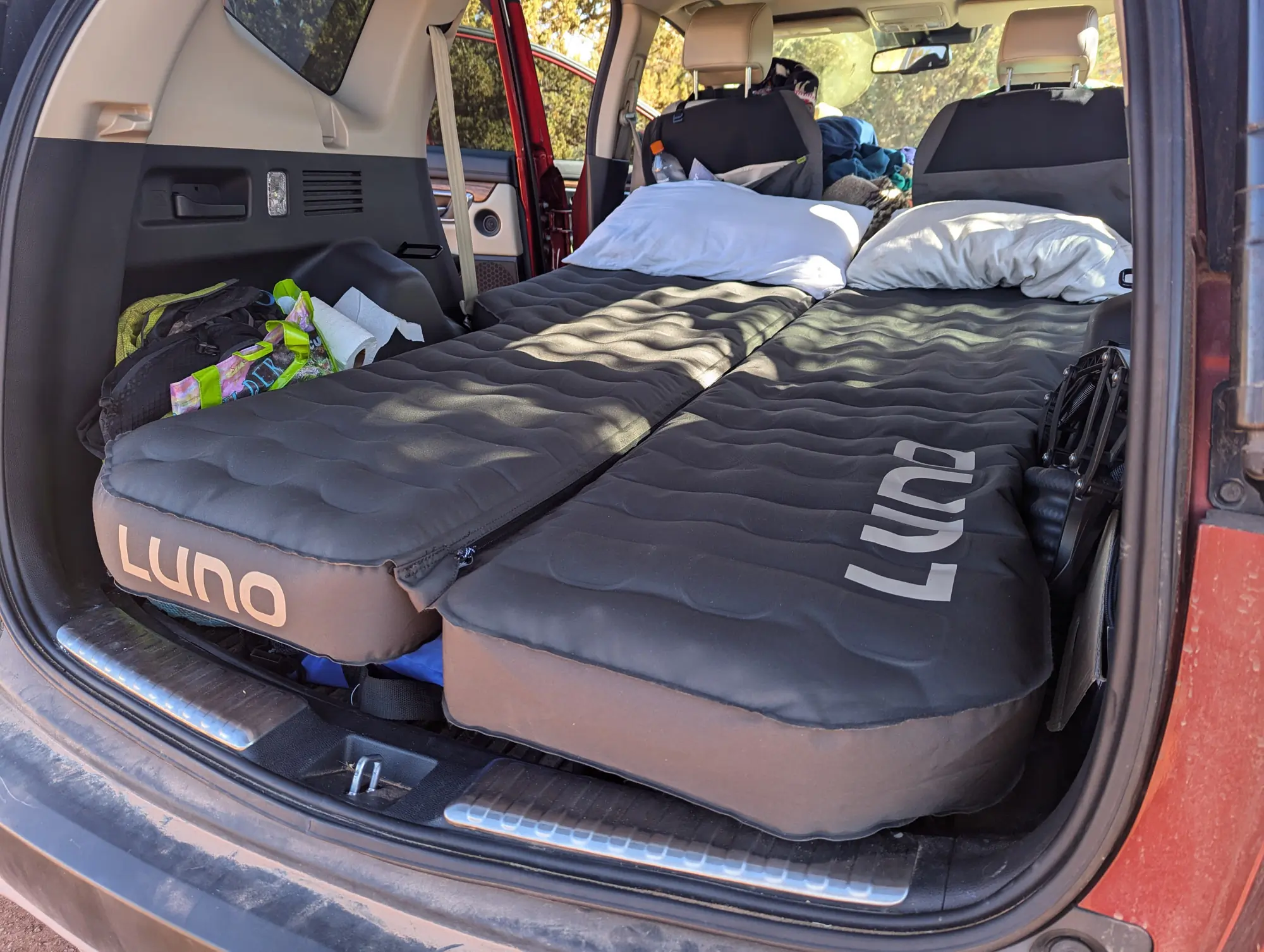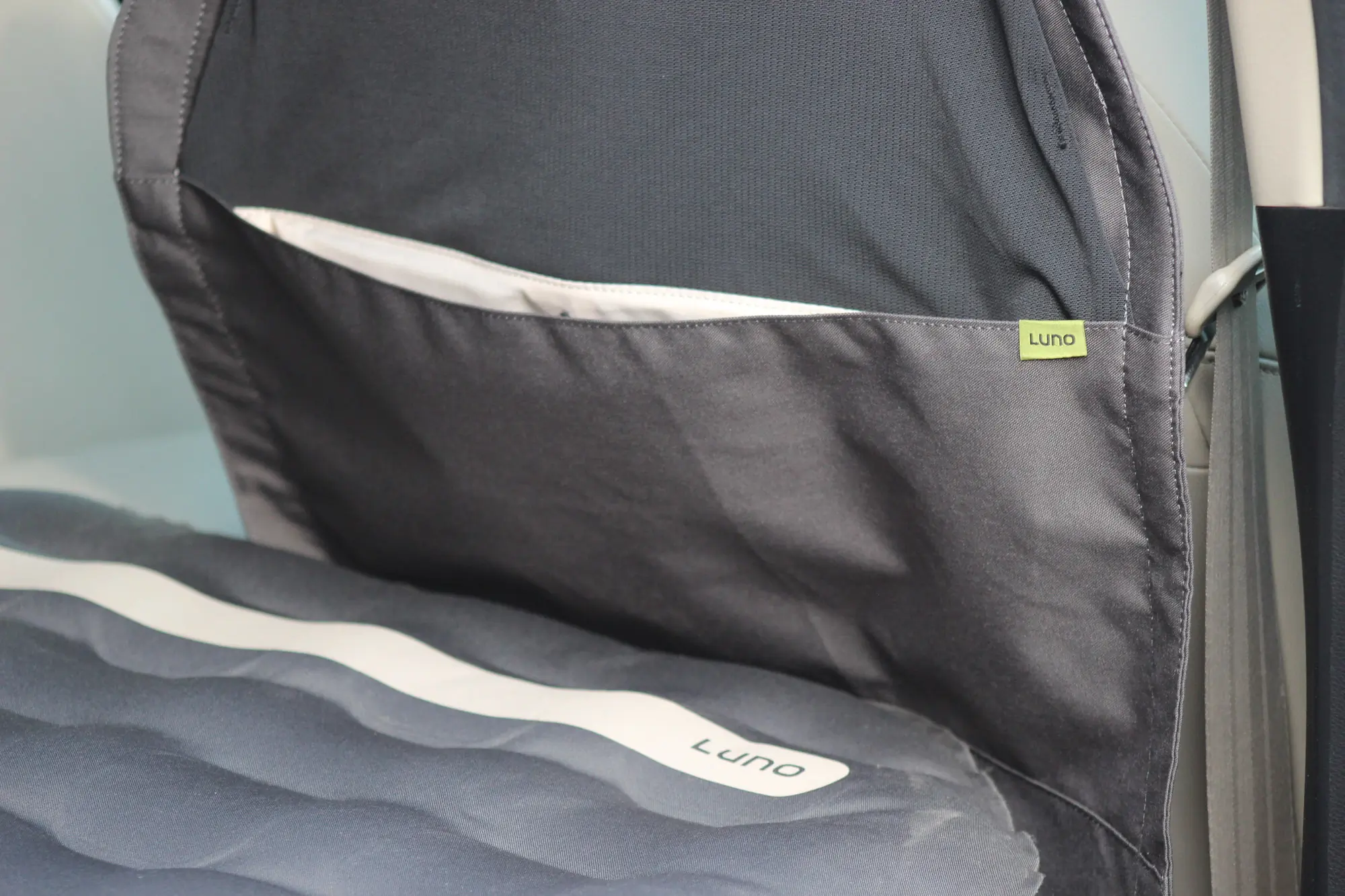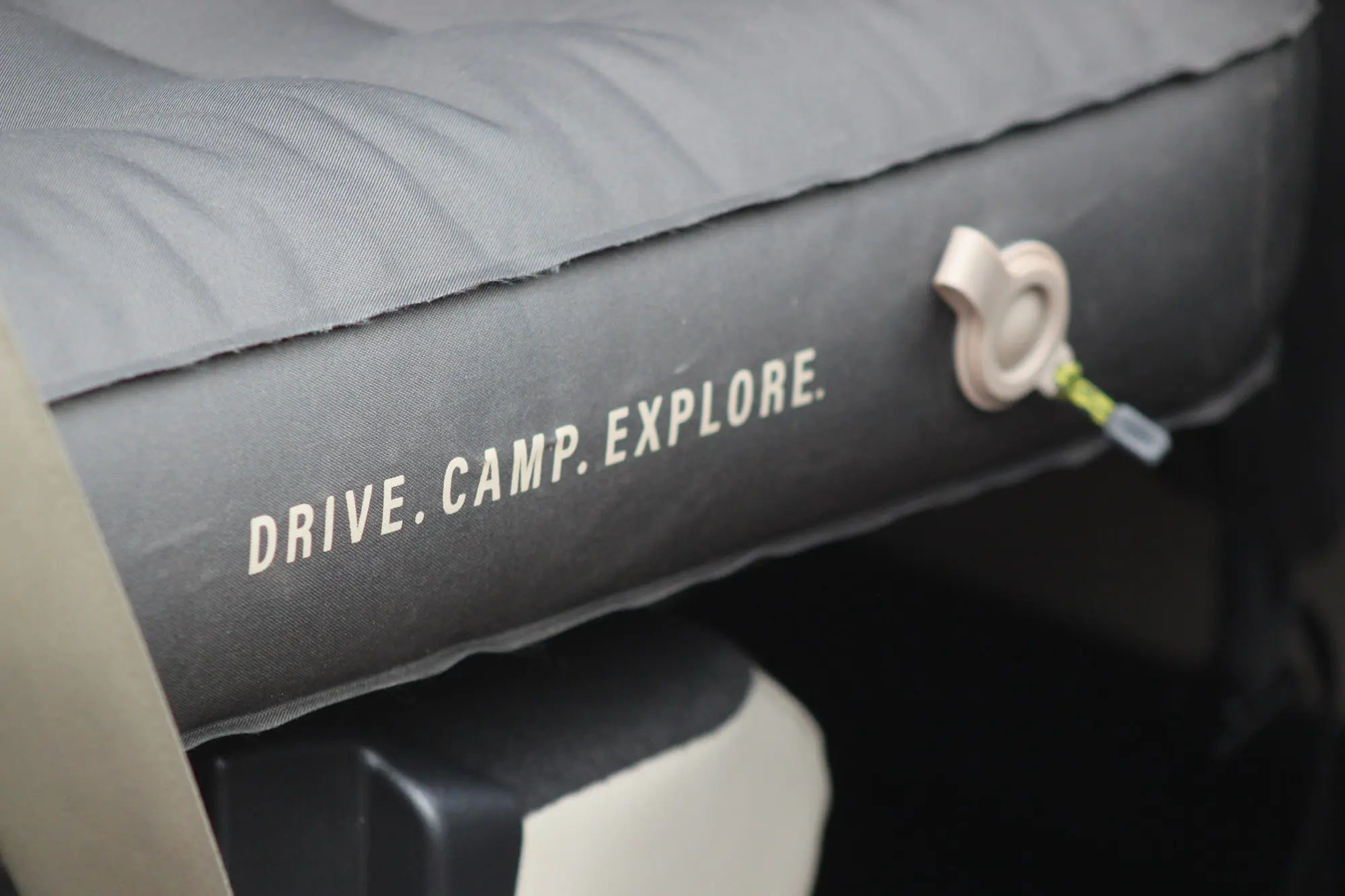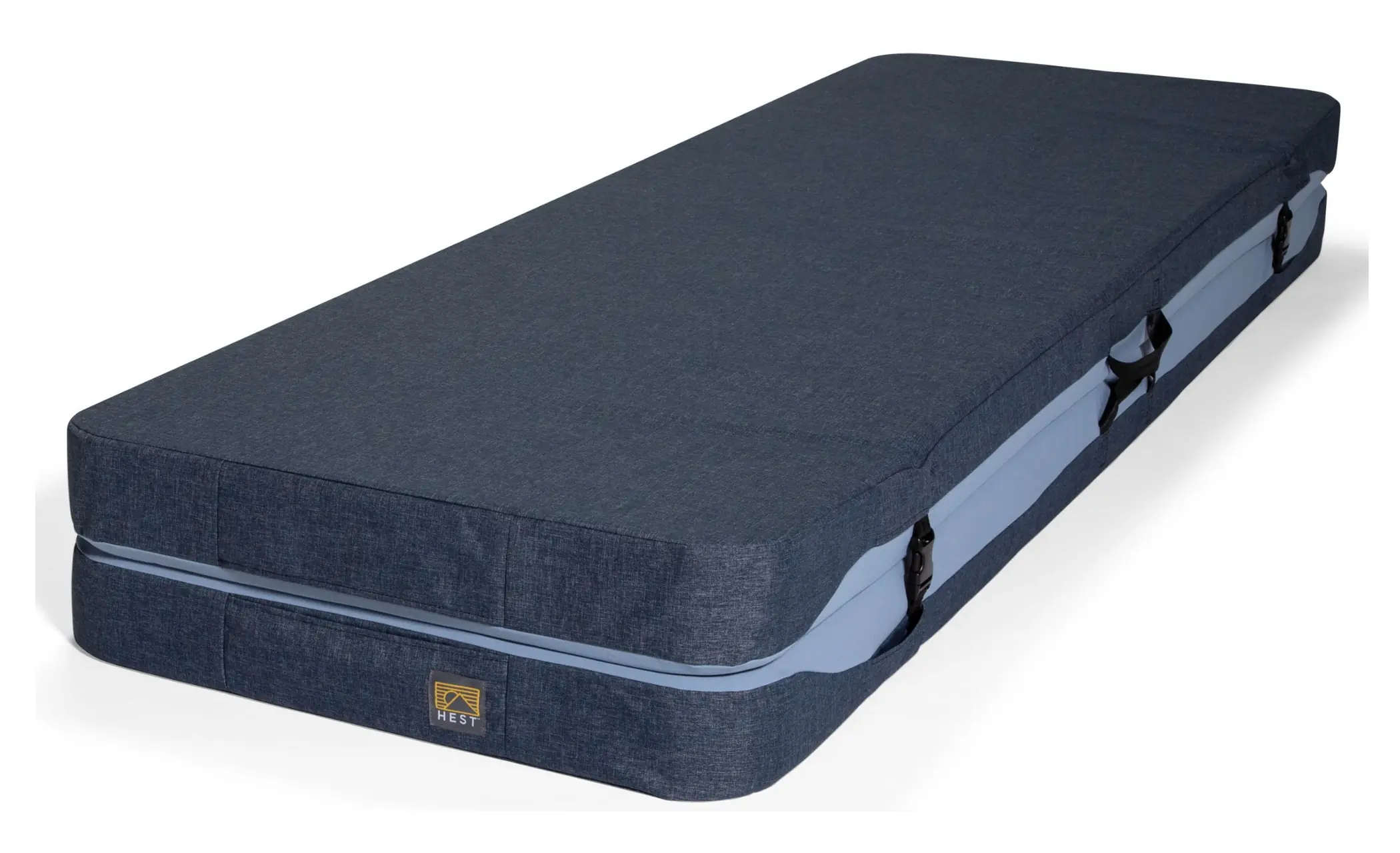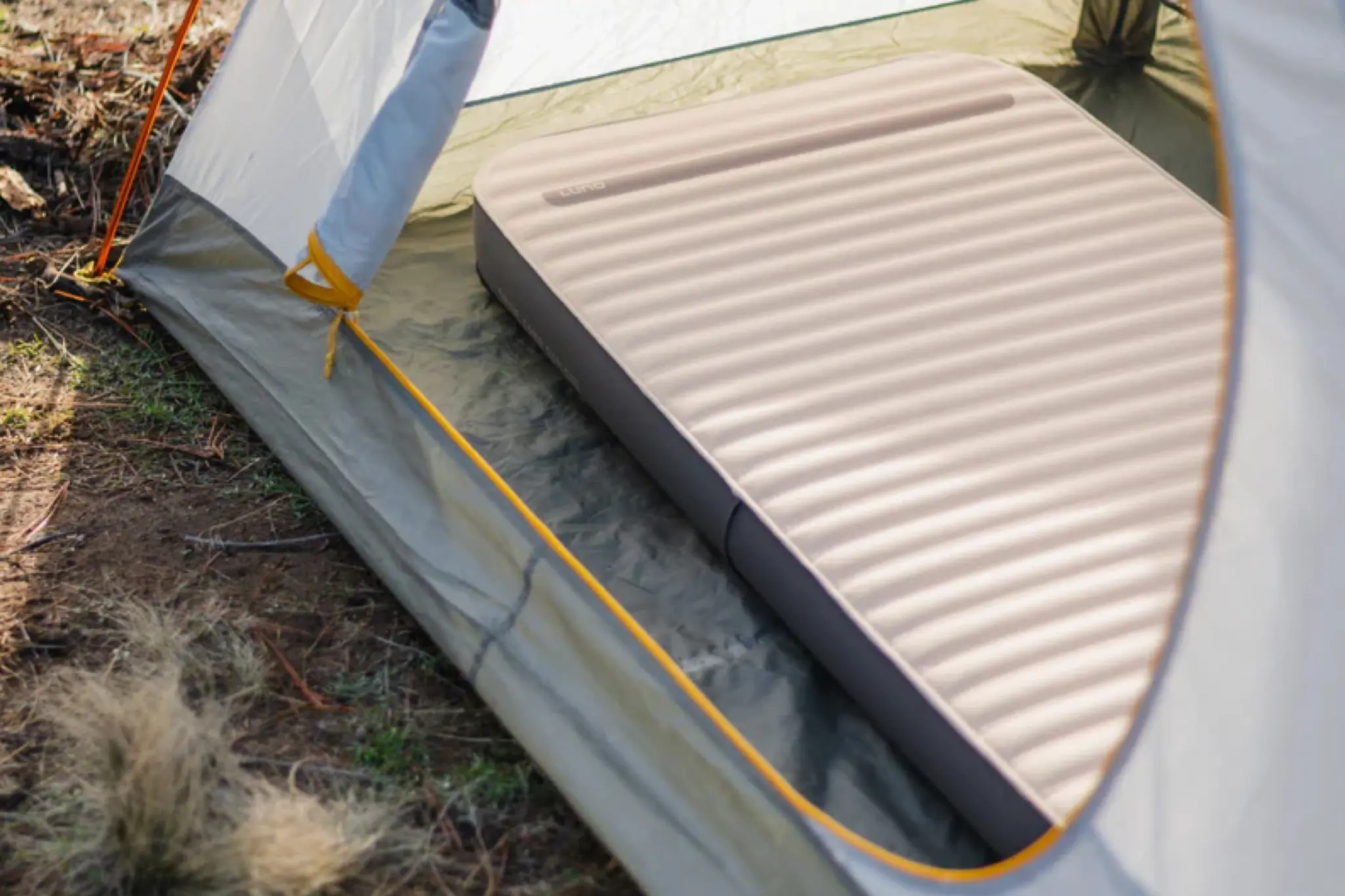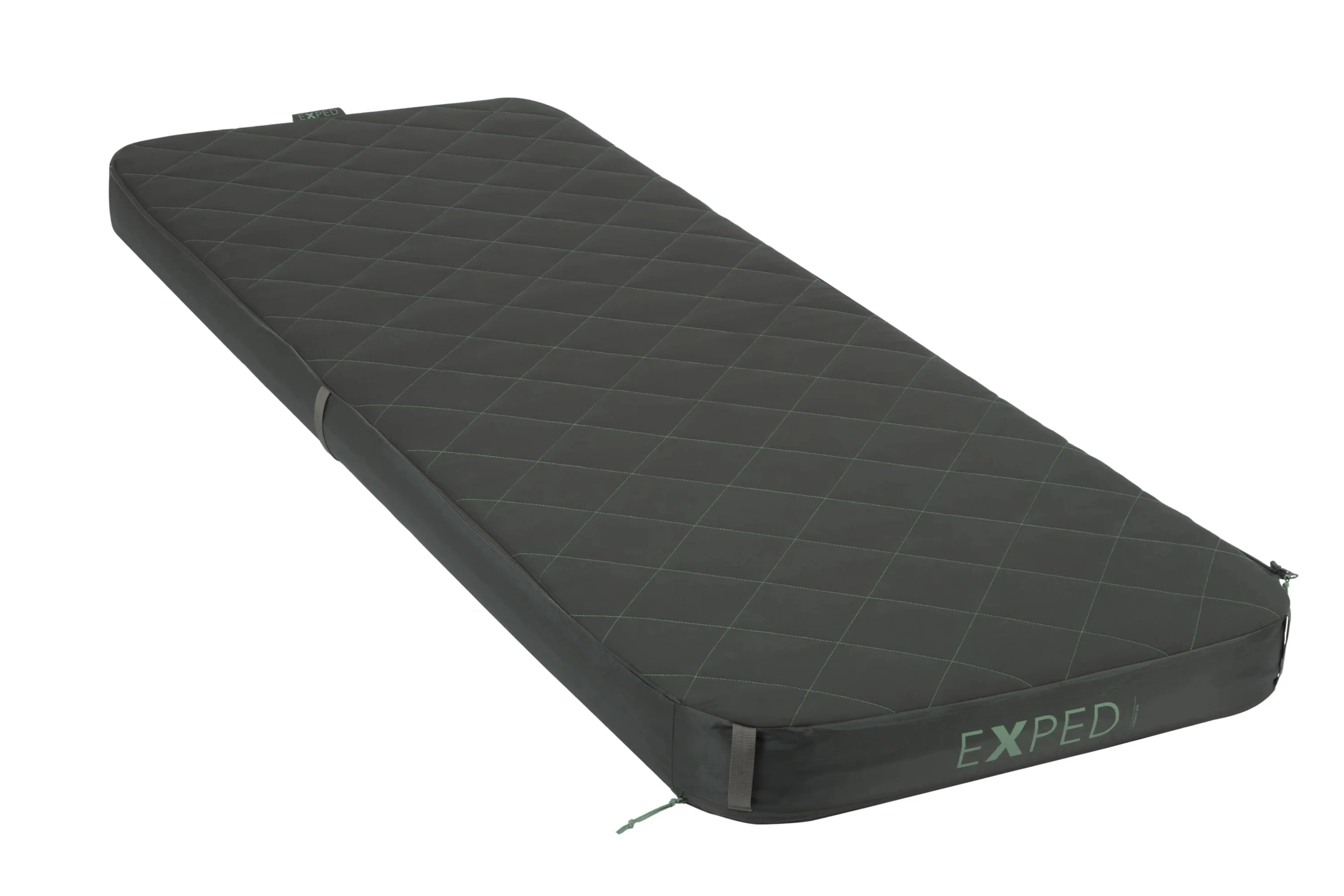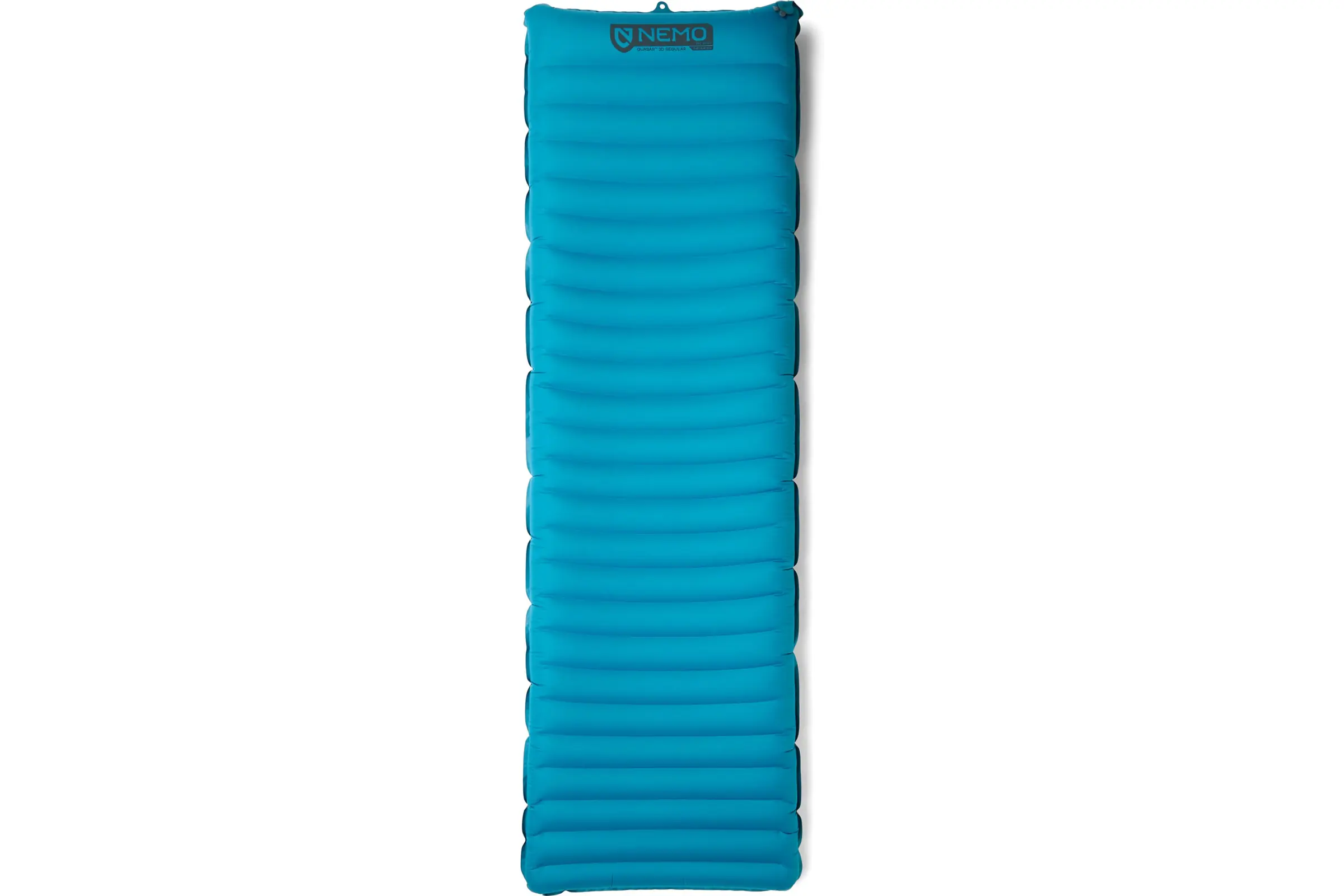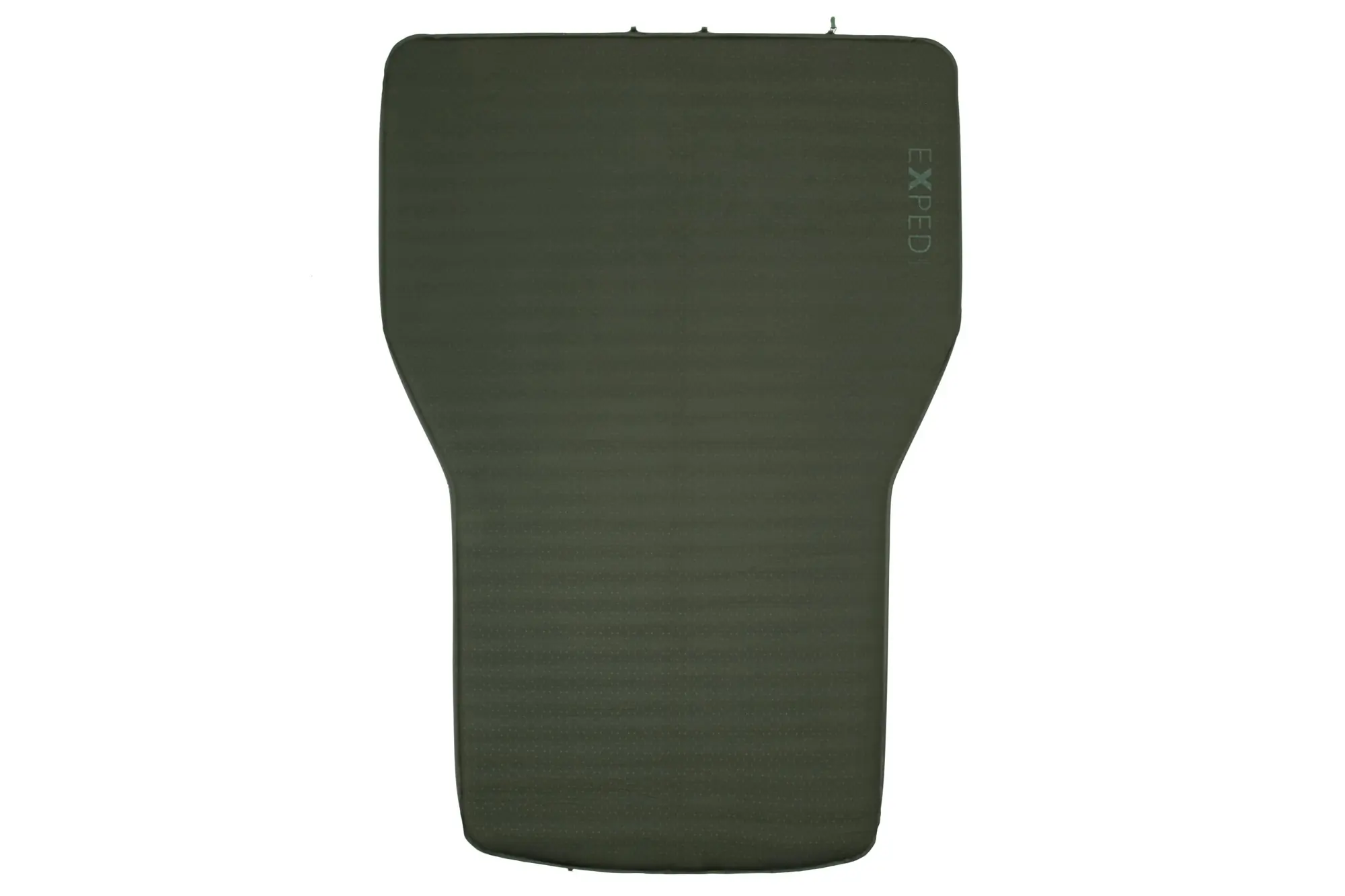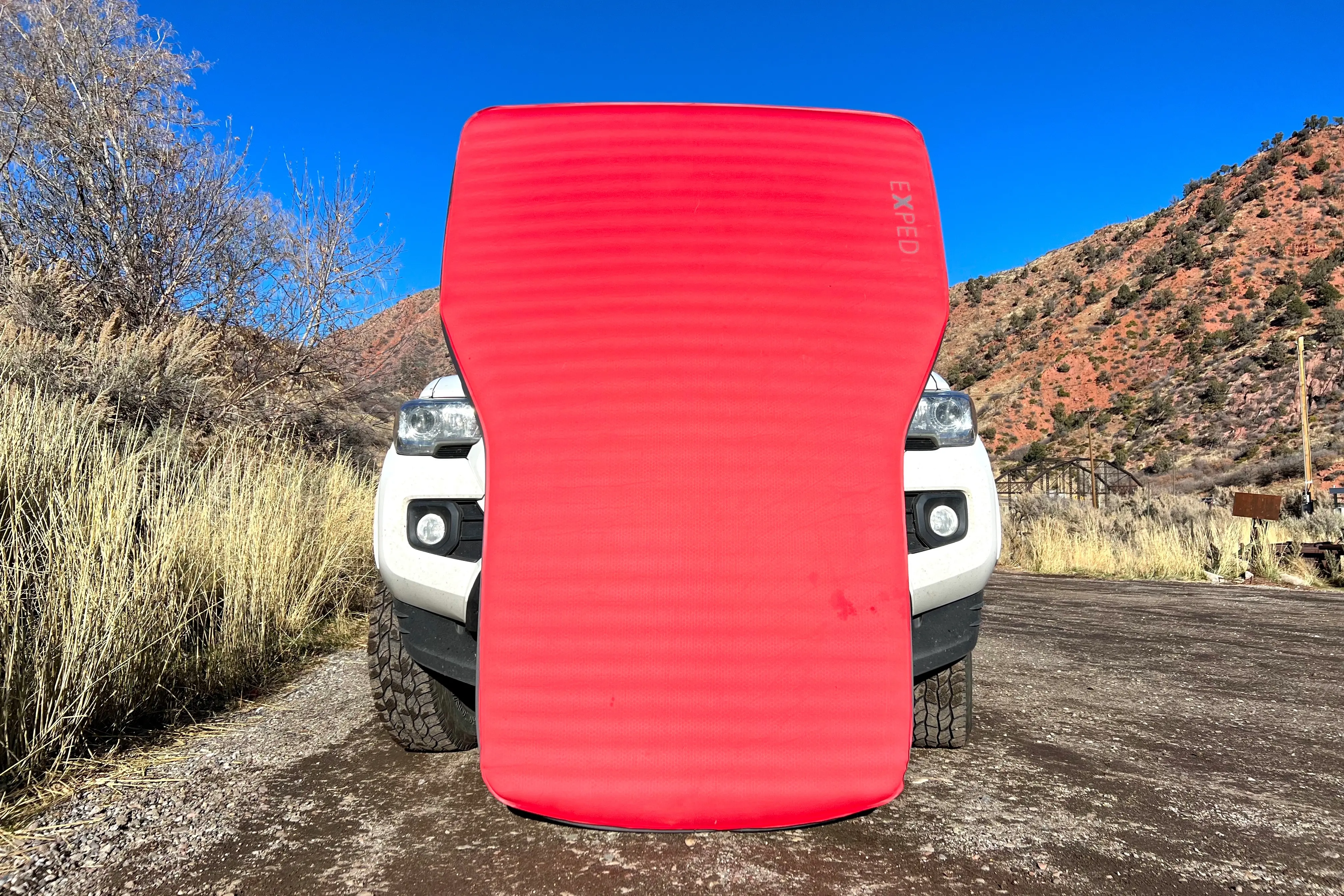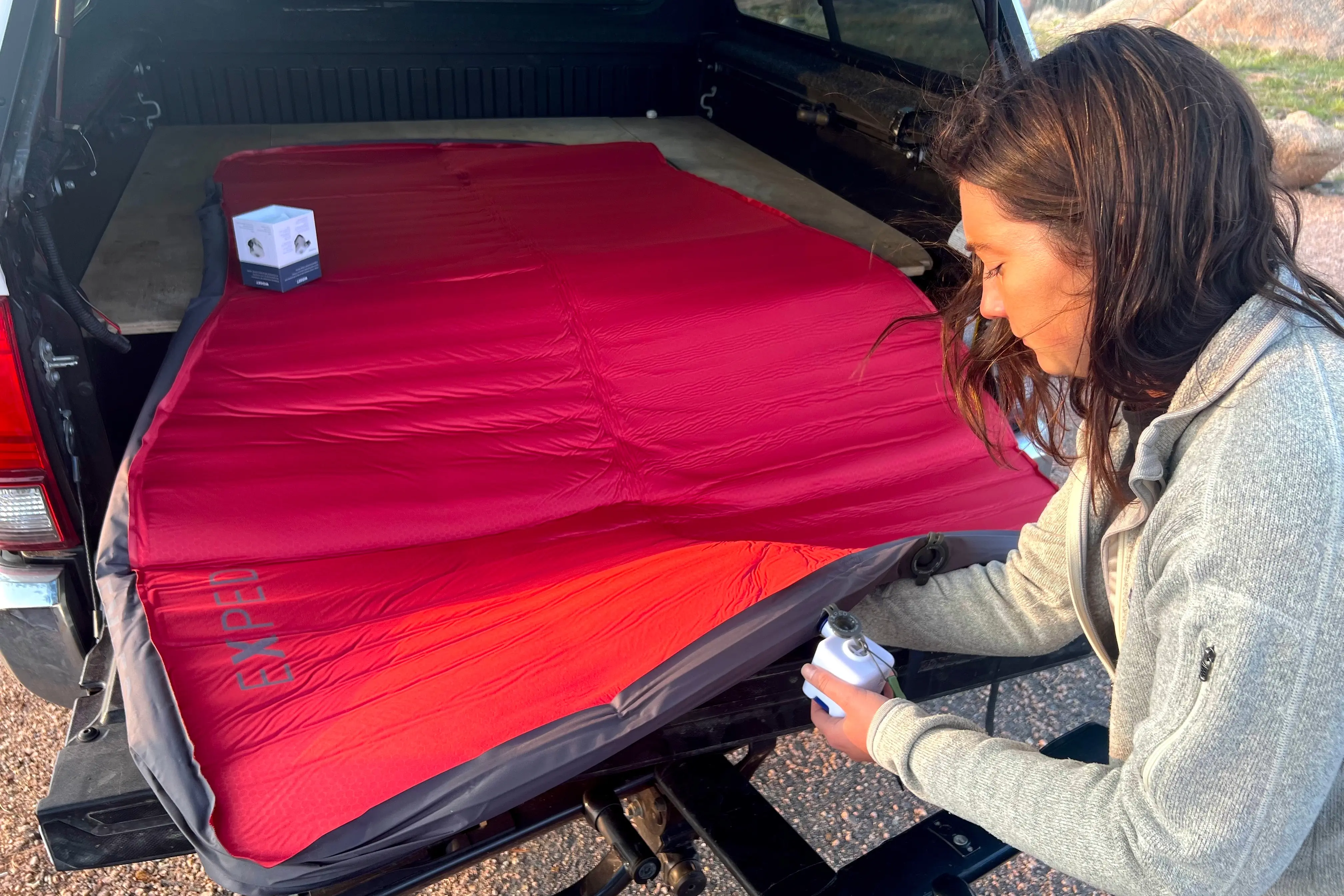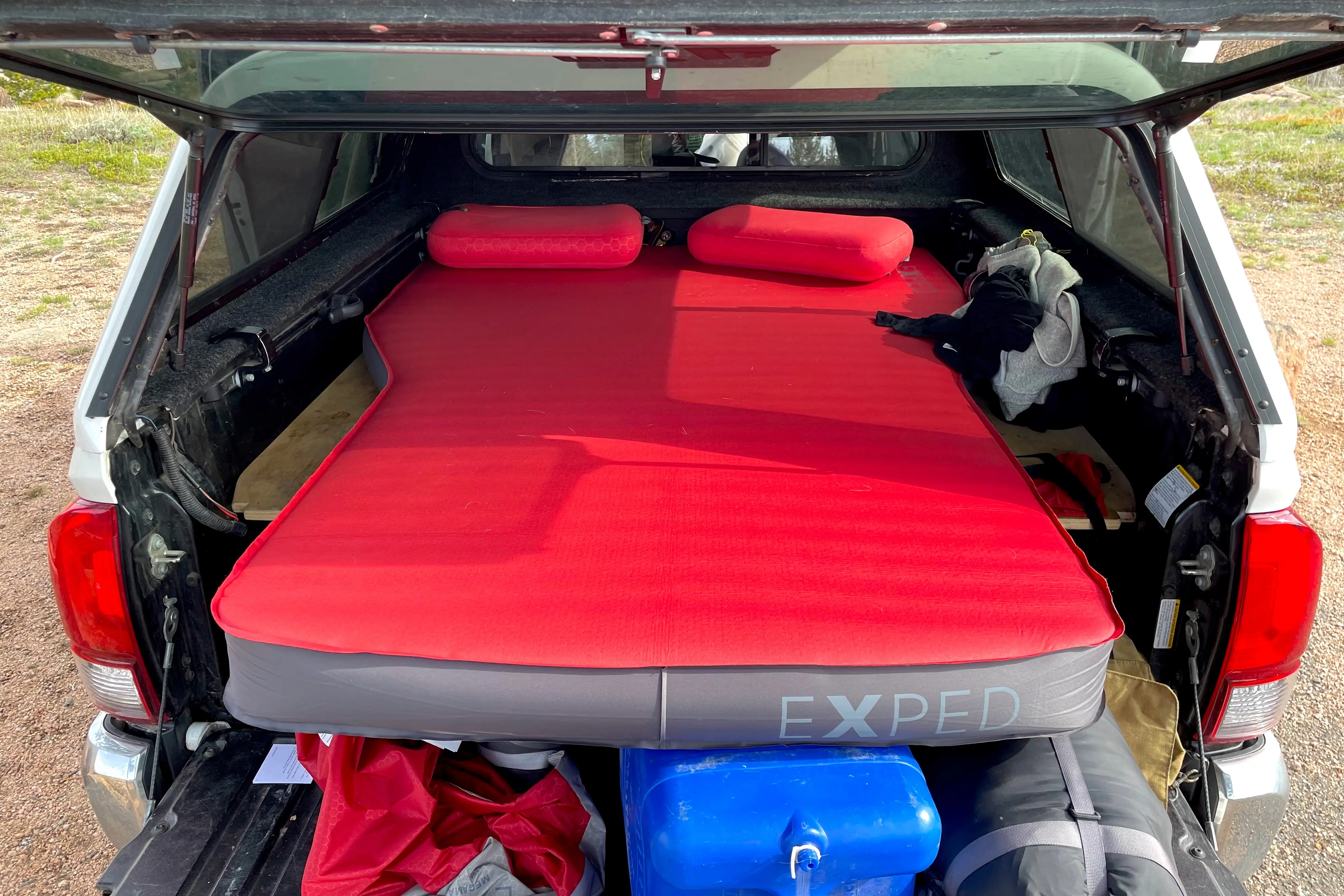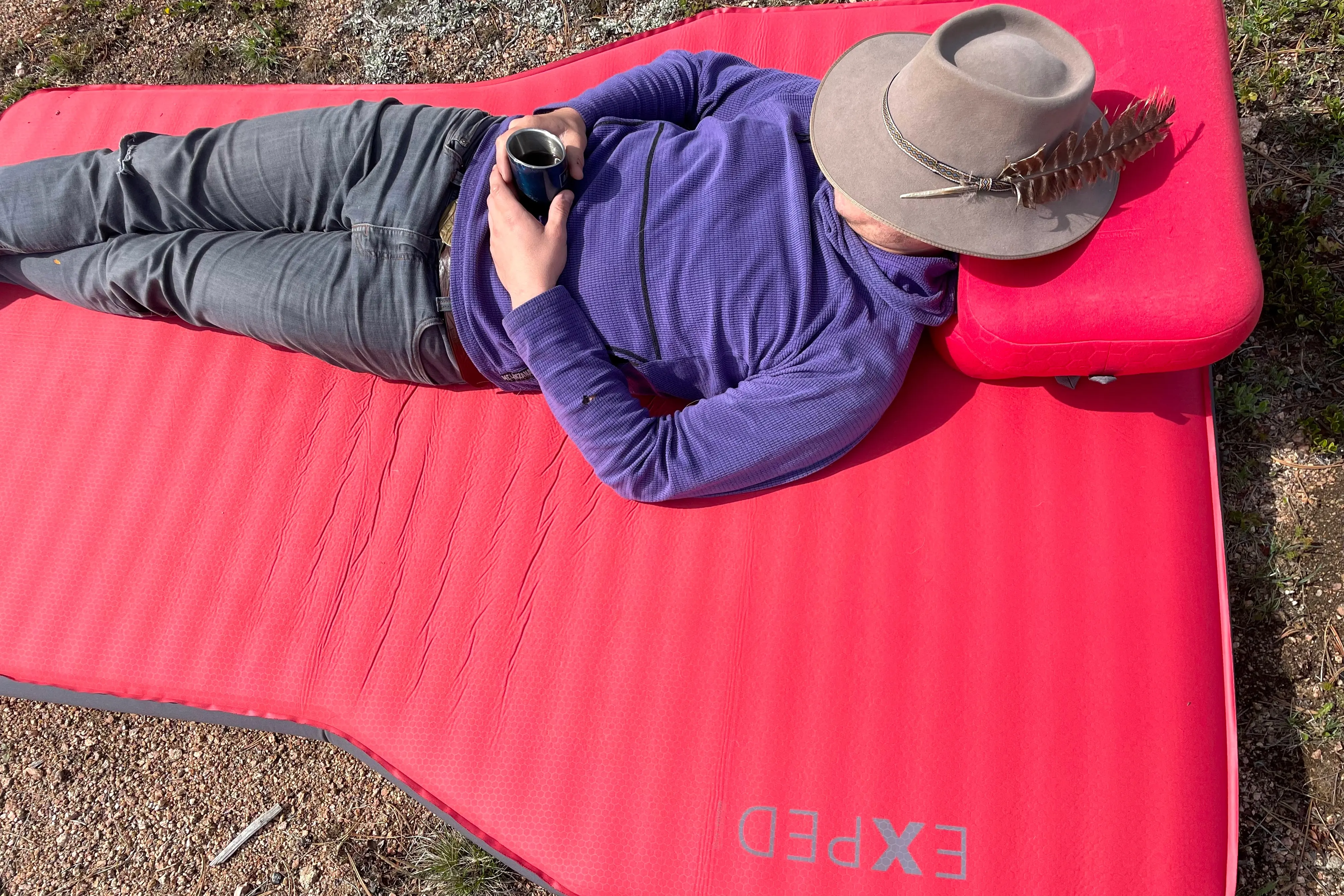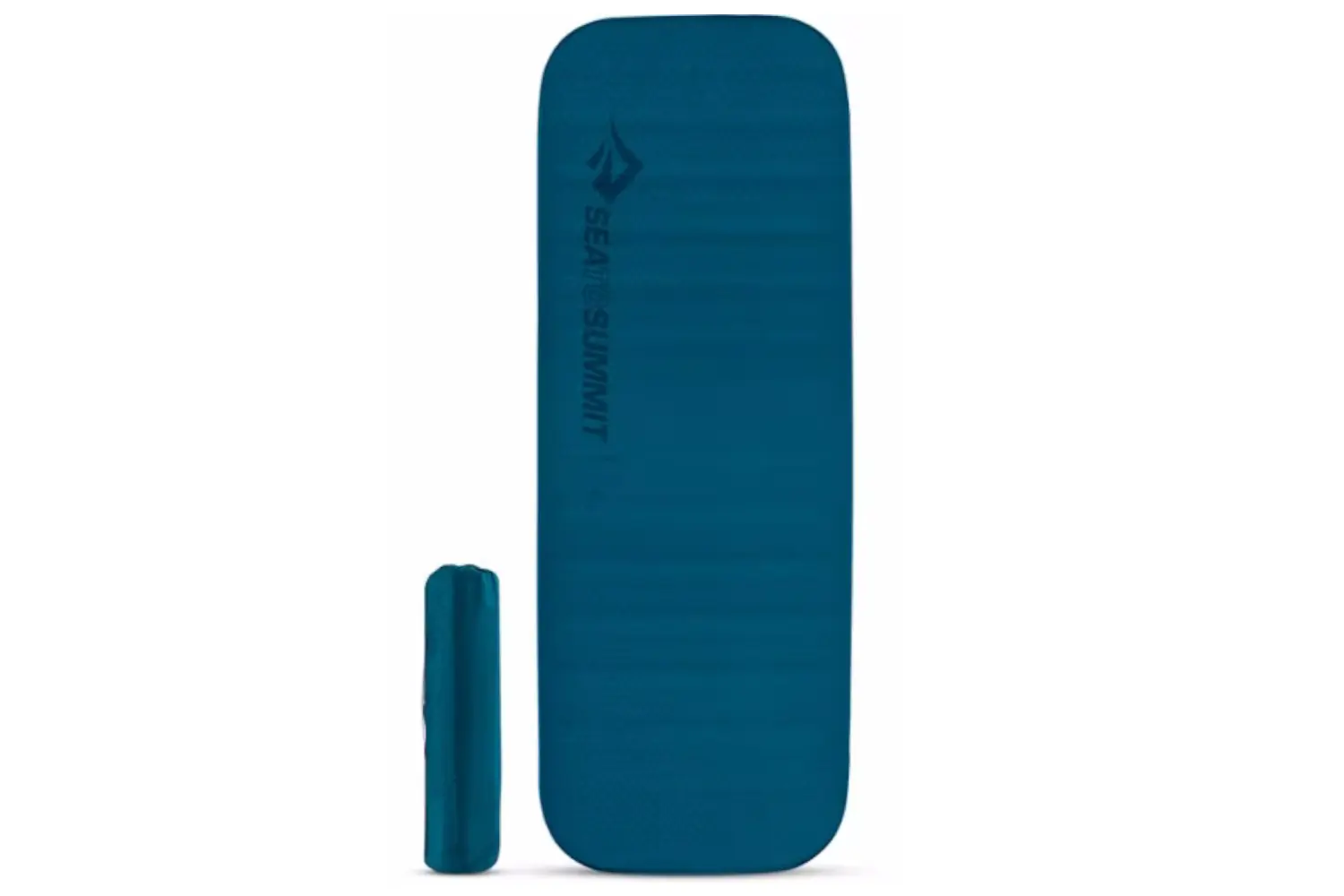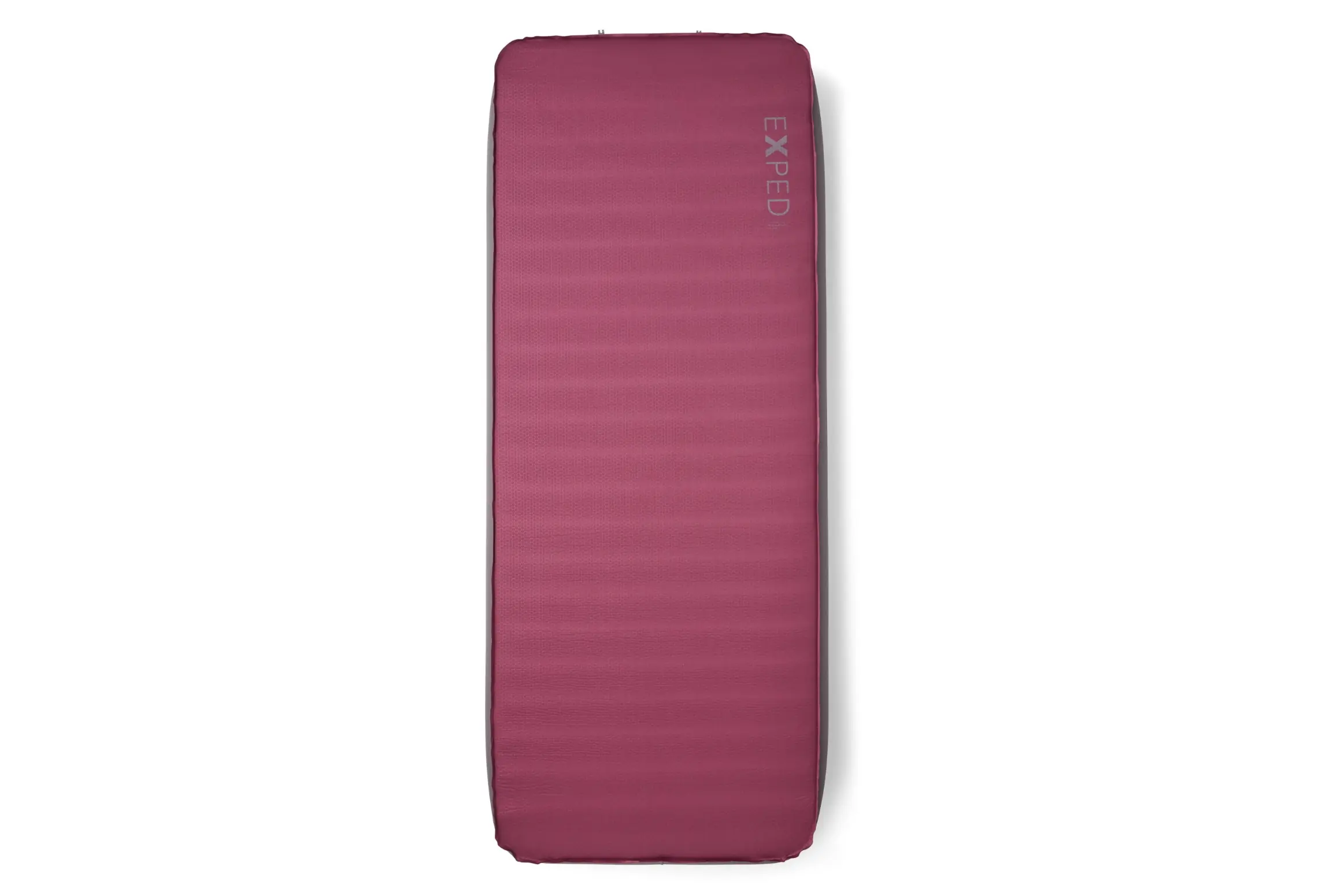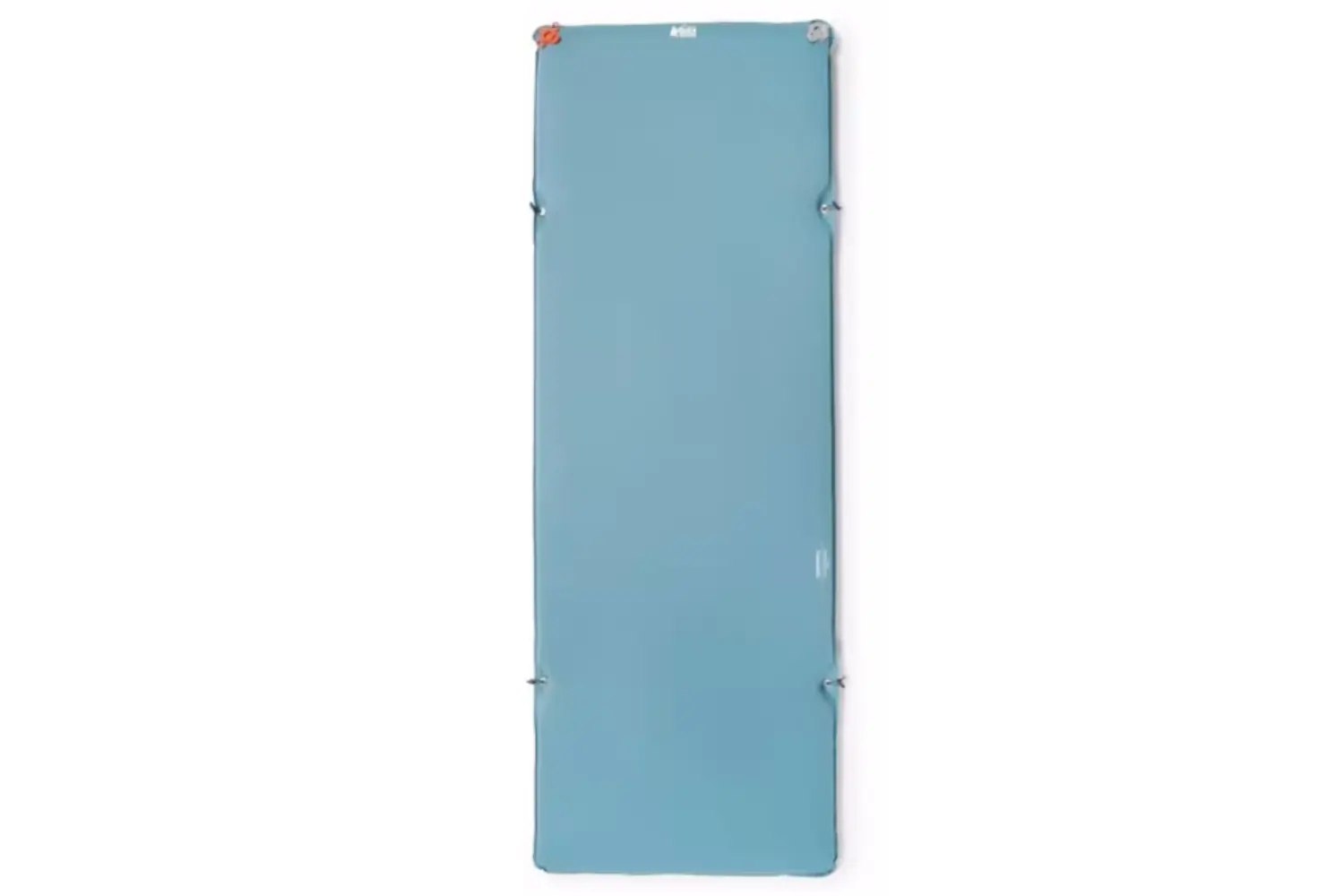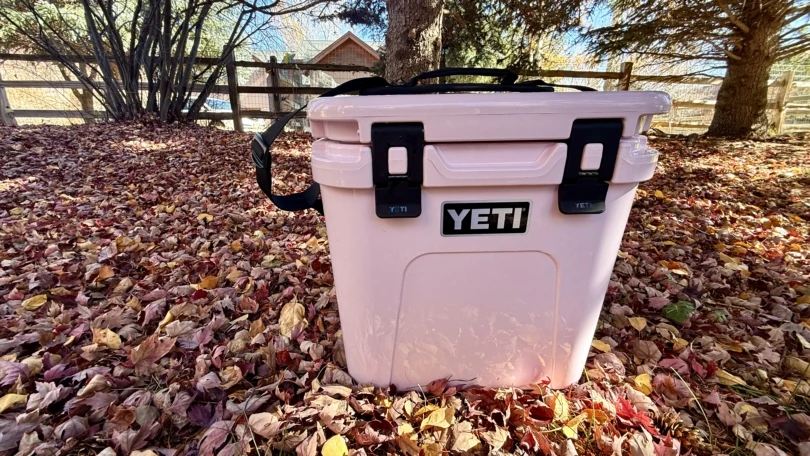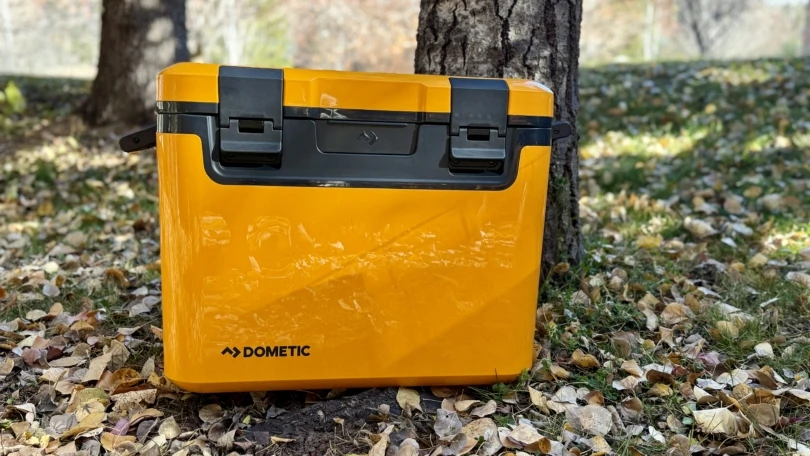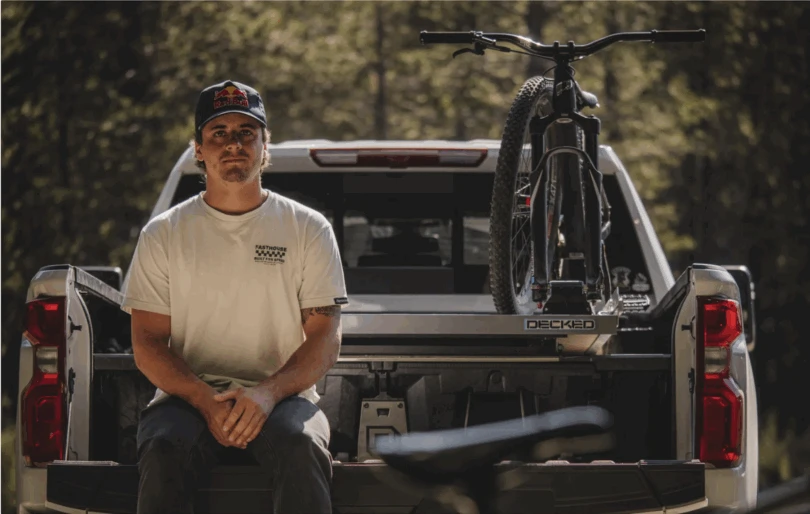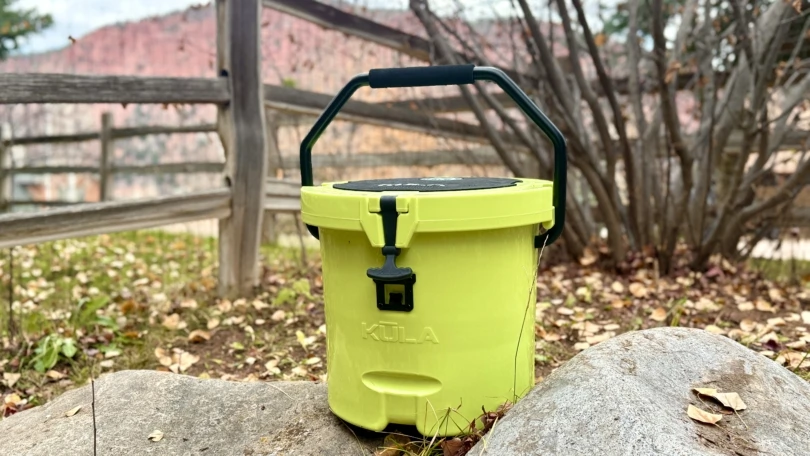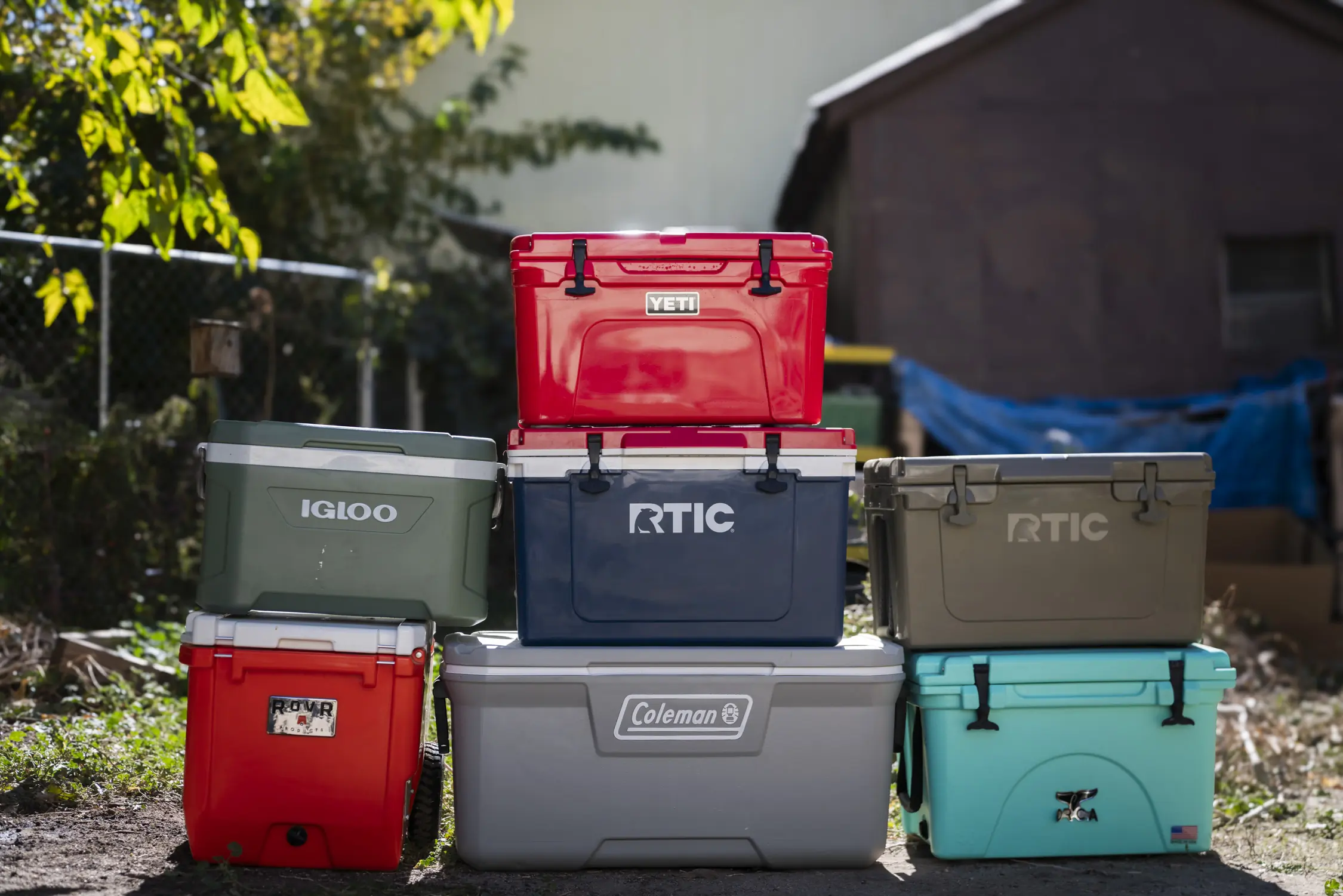For more than a decade, we’ve unfurled, inflated, and caught well-needed shut-eye on the best camping mattresses. After considering more than 100 mattresses and running them through our field and bench-testing regimens, I’ve keyed in on the 15 models to cover any camping situation with, from casual front country weekends to dirtbag bivies in the back of your rig.
We all have different needs in camping mattresses, so while there isn’t a single option that will suit everyone, I’ve broken them up into categories to help you find the right one for you. The choices aren’t skin-deep, either — in total, our team of experts has put in more than 400 hours of slumber over the seasons testing the best camping mattresses and sleeping pads on the market.
Whether you’re after the ultimate camping mattress (I highly recommend our top pick, the Therm-a-Rest MondoKing 3D) or need a more budget-friendly option to get the family kitted out, like the $179 REI Co-op Camp Dreamer XL, there’s something here for everyone. Read on for my top choices, as well as some additional options to consider.
Editor’s Note: We updated our Camping Mattresses guide on August 13, 2025 to add the LUNO AIR Pro Vehicle Mattress, our new favorite car-camping option. We also added expanded ratings to each pad for more insight into our field testing process.
The Best Camping Mattresses of 2025
Therm-a-Rest MondoKing 3D
-
Comfort
9.0
-
R-Value
9.0
-
Durability
8.0
-
Weight & Packability
8.0
- Pad Type: Self-inflating
- Sleeping Area: 77" x 25" (Large)
- Weight: 5 lbs., 8 oz.
- Packed Size: 10.3" x 26" rolled
- R-value: 7
- Thickness: 4.25"
- Material: Polyester, open-cell foam
Pros
- R-value of 7 is warm enough for winter use
- 4.25" thickness is a bit more than most
- Open-cell foam interior distributes weight well
- Durable exterior fabric
Cons
- Not as easy to inflate initially as other comparable pads
- Tube-style stuff sack requires extra work to fit pad into
REI Co-op Camp Dreamer XL
-
Comfort
7.0
-
R-Value
7.0
-
Durability
6.0
-
Weight & Packability
6.0
- Pad Type: Self-inflating
- Sleeping Area: 78" x 30"
- Weight: 6 lbs., 6 oz.
- Packed Size: 30" x 11" rolled
- R-value: 6.6
- Thickness: 4"
- Material: Polyester, open-cell foam
Pros
- Budget pricing
- Plush comfort
- Easy to use inflation and deflation valves
- Updated pump sack makes inflation a breeze
Cons
- Large packed size
- Doesn't come with a patch kit
NEMO Roamer XL Wide
-
Comfort
8.0
-
R-Value
7.0
-
Durability
6.0
-
Weight & Packability
7.0
- Pad Type: Self-inflating
- Sleeping Area: 78" x 30"
- Weight: 5 lbs., 8 oz.
- Packed Size: 10" x 16" rolled
- R-value: 6
- Thickness: 4"
- Material: 75-denier polyester, open-cell foam
Pros
- Distributes weight well across sleeping surface
- Durable exterior 75D fabric
- Connects to another Roamer pad to create a queen-size mattress
- Micro-adjust valves bleed air to fine-tune your comfort
Cons
- Bulky packed size
- Valve can develop leaks over time
EXPED MegaMat Duo 10
-
Comfort
9.0
-
R-Value
8.0
-
Durability
8.0
-
Weight & Packability
6.0
- Pad Type: Self-inflating
- Sleeping Area: 72" x 41" (Medium)
- Weight: 9 lbs., 14 oz.
- Packed Size: 11" x 22" rolled
- R-value: 9.5
- Thickness: 3.9"
- Material: 50-denier nylon top, 75-denier polyester bottom, open-cell foam
Pros
- Supremely comfortable
- Durable construction
- Doesn't translate movement between sleepers
- Generous sleeping area
Cons
- On the pricier side
- Large packed size can be tough to pack
- Heavy at near 10 pounds
Therm-a-Rest NeoAir Topo Luxe
-
Comfort
7.0
-
R-Value
6.0
-
Durability
7.0
-
Weight & Packability
9.0
- Pad Type: Air
- Sleeping Area: 72" x 25" (Regular Wide)
- Weight: 1 lb., 7 oz.
- Packed Size: 9.5" x 5.7" (rolled)
- R-value: 3.7
- Thickness: 4"
- Material: 50-denier polyester, nylon
Pros
- Sleeping platform is generous for solo use
- Packed size rivals some backpacking sleeping pads
- Internal structure limits the amount of bounce
- TwinLock valves make for easy inflation and deflation
Cons
- Non-vertical sidewalls mean less usable space
- Durability will be less than other sleeping pads
LUNO AIR Pro Vehicle Mattress
-
Comfort
8.0
-
R-Value
5.0
-
Durability
9.0
-
Weight & Packability
8.0
- Pad type: Air
- Sleeping area: 2-person
- Weight: 13 lbs.
- Packed size: 8" x 26" rolled
- R-value: 1.5
- Thickness: 4"
- Material: 300D Oxford fabric top, reinforced coating on bottom
Pros
- Quick setup and breakdown
- Comfortable sleeping area
- Rugged construction with burly underside
- Solo or twin configuration
Cons
- Only fits certain vehicles
- Higher end of the price range
- Low R-value
HEST Dually
-
Comfort
8.0
-
R-Value
7.0
-
Durability
9.0
-
Weight & Packability
6.0
- Pad Type: Closed-cell foam
- Sleeping Area: 78" x 50" (Long)
- Weight: 32 lbs.
- Packed Size: 78" x 25" x 7.8"
- R-value: Unavailable
- Thickness: 3.9"
- Material: Polyurethane-backed nylon, two types of polyfoam
Pros
- Highly durable all-foam design
- Ideal for truck bed camping; folds in half for quick storage
- Two types of foam for both firm and soft support
- Center fold design doesn't lack support
Cons
- Expensive
- Large overall packed size
Other Camping Mattresses We Recommend
The mattresses above are the cream of the crop, as far as I’m concerned, and would make excellent choices for anyone looking for a solid night’s sleep outdoors. That said, there are a number of other excellent sleeping pads out there, and while they weren’t quite as impressive as our award-winners, we still think they’re worthy of consideration.
-
Comfort
8.0
-
R-Value
8.0
-
Durability
7.0
-
Weight & Packability
8.0
- Pad Type: Self-inflating
- Sleeping Area: 72" x 25" (regular)
- Weight: 6 lbs., 7 oz.
- Packed Size: 7" x 26" rolled
- R-value: 11.4
- Thickness: 4"
- Material: Stretch polyester top, TPU-coated bottom, polyurethane foam
Pros
- Novel head support bridge makes this pad easy to use in car camping setups
- 11.4 R-value is super warm (and the warmest in our line up)
- No stuff sack to wrangle, but instead uses a storage wrap
- Stretch fabric on top is quite soft to sleep on
Cons
- Inflation and deflation valves aren't very impressive, but work
- Included pump sack is a bit low volume
-
Comfort
9.0
-
R-Value
7.0
-
Durability
8.0
-
Weight & Packability
7.0
- Pad Type: Self-inflating
- Sleeping Area: 72" x 25.6" (Medium Wide)
- Weight: 6 lbs., 12.3 oz.
- Packed Size: 26.4" x 7.9" rolled
- R-Value: 7.2
- Thickness: 4"
- Material: Organic cotton and wool cover, recycled polyester TPU core with open-cell polyurethane foam
Pros
- Cozy knit cotton cover is insulated with wool, and is super soft next-to-skin
- Added organization pockets on cover keeps essentials close
- Zippers on edges to combine pads together with double-wide bed, or couch
Cons
- Heavier than the similar MegaMat 10
- On the pricier side
-
Comfort
8.0
-
Warmth
6.0
-
Packed Size
7.0
-
Material Durability
7.0
- Pad Type: Air
- Sleeping Area: 72" x 20" (Regular)
- Weight: 1 lb., 12 oz.
- Packed Size: 8" x 4.5" rolled
- R-value: 3.3
- Thickness: 3.5"
- Material: 30-denier polyester ripstop
Pros
- Excellent packed size
- Body-contoured pad baffles and elevated head
- Vortex pump sack works great
- Great option for side sleepers
Cons
- Finicky valve system
- Not quite as warm as comparable pads
- Pad Type: Self-inflating
- Sleeping Area: 77" x 52/41" (head/foot)
- Weight: 8 lbs.
- Packed Size: 27" x 12" rolled
- R-value: 8.1
- Thickness: 4"
- Material: Open-cell foam
Pros
- Stows and travels easily
- Two sets of inflate and deflate valves makes set-up easy from either direction
- Well insulated and comfortable
- Fits in most mid-size trucks, compact SUVs and wagons, and Tesla models
Cons
- Not ideal for 5-foot truck beds
- Takes a while to inflate (electric pumps don't get it very firm)
- Pad Type: Self-inflating
- Sleeping Area: 72" x 25" (Regular Wide)
- Weight: 4 lb., 6.4 oz.
- Packed Size: 7" x 26.5" rolled
- R-value: 6.5
- Thickness: 4"
- Material: 30D polyester knitted upper, 75D polyester base, open-cell foam
Pros
- Just right thickness at 4"
- 30D stretch knit upper is soft to the touch
- 6.5 R-value stretches use into winter
- Vertical sidewalls increases sleeping area
Cons
- Multi-direction valve isn't as refined as some out there
- Can be tough to get back into stuff sack
- Pad Type: Self-inflating
- Sleeping Area: 78" x 30" (Long Wide)
- Weight: 7 lbs., 9 oz.
- Packed Size: 11" x 31.1" rolled
- R-value: 10.6
- Thickness: 6"
- Material: 50-denier nylon top, 75-denier polyester bottom, open-cell foam
Pros
- Air-mattress thickness without the bounce
- Includes Exped Mini Pump for inflation top off
- Durable 75D polyester bottom material
Cons
- Packed size is a beast
- Pricey
- Pad Style: Self-inflating
- Sleeping Area: 72" x 25" (Regular)
- Weight: 3 lbs., 8 oz.
- Packed Size: 6.2" x 26" rolled
- R-Value: 7
- Thickness: 2.5"
- Material: Soft stretch polyester top, recycled polyester bottom, open-cell foam
Pros
- Great value for the money
- Toggle system for securing pads together or to cot is novel
- Simple inflation and deflation valves
- Impressive R-value for the price
Cons
- Not as thick as many other camping mattresses
- No included inflation sack
Best Camping Mattresses Comparison Chart
| Camping Mattress | Price | Weight | Packed Size | R-Value | Thickness |
|---|---|---|---|---|---|
| Therm-a-Rest MondoKing 3D | $250 | 5 lbs., 8 oz. | 10.3″ x 26″ rolled | 7 | 4.25″ |
| REI Co-op Camp Dreamer XL | $199 | 5 lbs., 6 oz. | 32″ x 10″ rolled | 6.6 | 4″ |
| NEMO Roamer | $250 | 5 lbs., 8 oz. | 10″ x 16″ rolled | 6 | 4″ |
| EXPED MegaMat Duo 10 | $370-520 | 9 lbs., 14 oz. | 11″ x 22″ rolled | 9.5 | 3.9″ |
| Therm-a-Rest NeoAir Topo Luxe | $180-230 | 1 lb., 7 oz. | 9.5″ x 5.7″ rolled | 3.7 | 4″ |
| LUNO Vehicle AIR Pro Mattress | $349 | 13 lbs. | 8″ x 26″ rolled | 1.5 | 4″ |
| HEST Dually | $549-579 | 32 lbs. | 78″ x 25″ x 7.8″ | N/A | 3.9″ |
| LUNO Air+Foam Pro | $280 | 6 lbs., 7 oz. | 7″ x 26″ rolled | 11.4 | 4″ |
| EXPED LuxeMat | $350-400 | 6 lbs., 12 oz. | 26.4″ x 7.9″ rolled | 7.2 | 4″ |
| NEMO Quasar 3D | $160-200 | 1 lb., 12 oz. | 8″ x 4.5″ rolled | 1.8 / 3.3 | 3.5″ |
| EXPED MegaMat Auto | $400 | 8 lbs. | 27″ x 12″ rolled | 8.1 | 4″ |
| Sea to Summit Camp Deluxe | $249 | 4 lb., 6.4 oz. | 7″ x 26.5″ rolled | 6.5 | 4″ |
| EXPED MegaMat Max | $300 | 7 lbs., 9 oz. | 11″ x 31.1″ rolled | 10.6 | 6″ |
| REI Co-op Campwell | $119 | 3 lbs., 8 oz. | 6.2″ x 26″ rolled | 7 | 2.5″ |

How We Tested the Best Camping Mattresses
Finding the perfect camping mattress isn’t always a cut-and-dry affair, and we aren’t the type to take bad advice lying down. That’s why we’ve spent hours researching and field-testing camping mattresses and sleeping pads for this guide over multiple summer seasons.
My selection is based on input from backpackers and campers across the country. During testing, I considered all facets of a proper camping mattress, including packed size, comfort, warmth, and ease of use. I also looked at long-term durability and the value you’re getting for your money.
Our Testing Process and Testing Grounds
Our camping mattress field testing takes us to some beautiful places, but the goal is always the same: formulate a real opinion on the comfort and ease of use of these pads. We take every pad we test out into the hills on multiple camping trips, cycling them between in-house experts and getting hours of slumber atop them to form our opinions.
Because a good night’s sleep is subjective, we also shove off camping mattresses and pads into the packs of talented gear testers and friends — ensuring that we have input from all types, including the tall to petite, side or back sleeper, and thru-hiker to the weekend warrior.
These camp mattresses have traveled in the backs of overlanding rigs to lofty pullouts above Colorado, been unfurled in the high-alpine fire lookout towers of the Pacific Northwest, and been toted to campgrounds across the country.
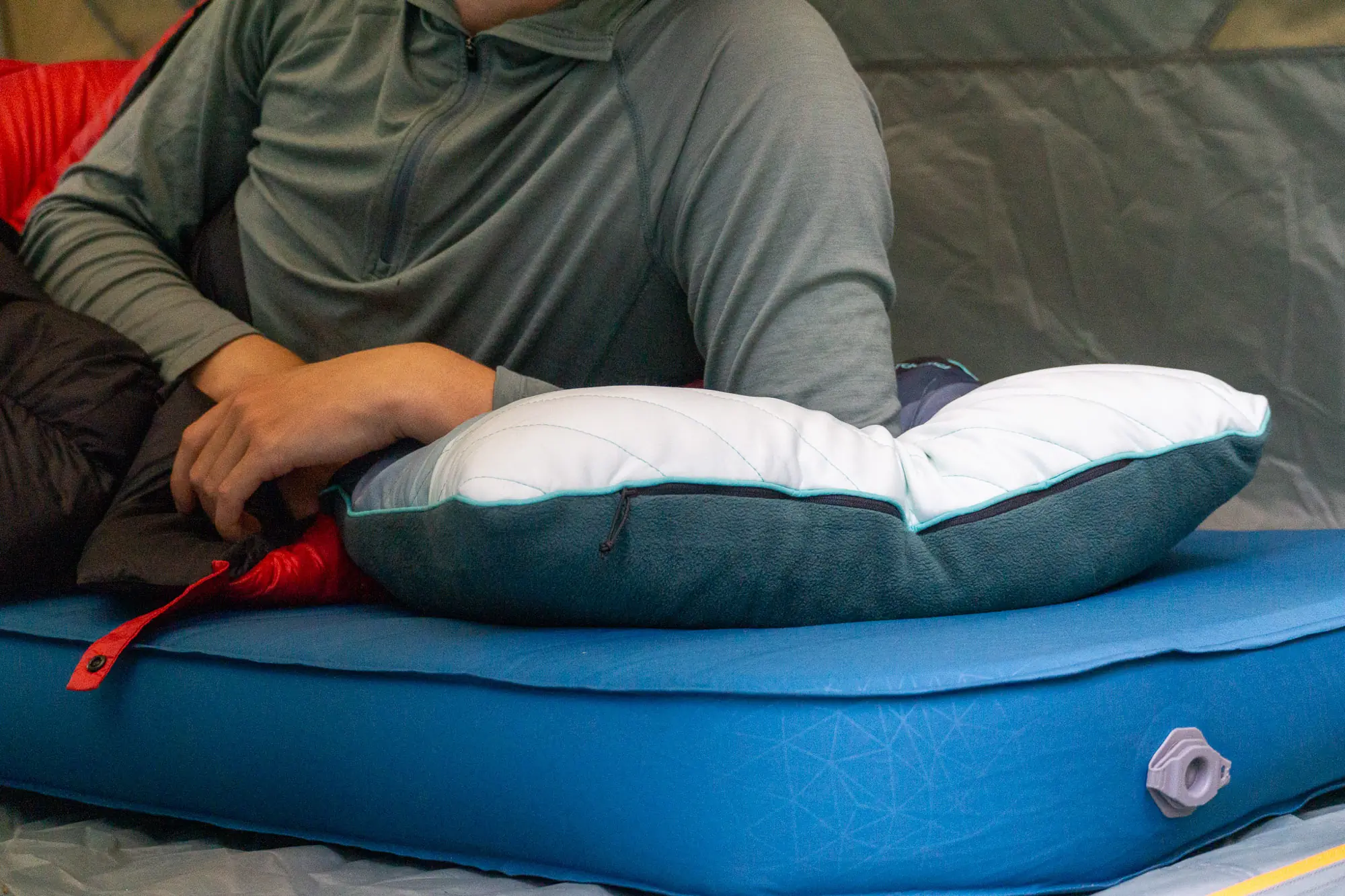
We also aren’t afraid of getting a little techy here, and that boiled down to a few key bench tests when it came to camping mattresses. Ground-truthing brand measurements was an easy lift, and we stacked up claimed packed sizes and thicknesses against our trusty tape measurer to ensure accuracy.
Inflation and deflation times were also timed using the same inflation pump and in the customary fashion while deflating: with a sleepy, full-sized adult atop the pad. Finally, we measure cushion by inflating the mattresses to their maximum and placing a 15-pound kettlebell atop them, simulating a leaning elbow or hip.
The mattresses’ deflection is measured and compared, and all of our data is compiled to stack these pads side-by-side. Often, our recommendations come down to a few degrees of difference.
Our Expert Testers
I, Senior Editor Nick Belcaster, lead our current testing efforts, and am an itterant wilderness guide based between the mountains of the Cascades and the waters of the Salish Sea in Washington State. I’ve spent entire seasons sleeping outdoors while hiking the Pacific Crest Trail and have years of experience equipping outdoor enthusiasts to bed down in some of the most challenging terrain.
To date, our team has saddled up for sleep atop more than 25 different camping mattresses and have nearly 300 hours of shuteye logged in our search for the best of the best for any circumstances. We know that every camping trip may look a little different, which is why we’ve scanned the spectrum of options and tested everything from lightweight pads that’ll do double-duty in backpacking and camping, to mondo-sized 6-inch-thick mattresses that’ll rival your own at home.
At the end of the day, I’m confident these are the best camping mattresses available today. As new pads hit the market, we’ll incorporate them into our testing to ensure our line-up is hip to the latest trends in backcountry bedding.
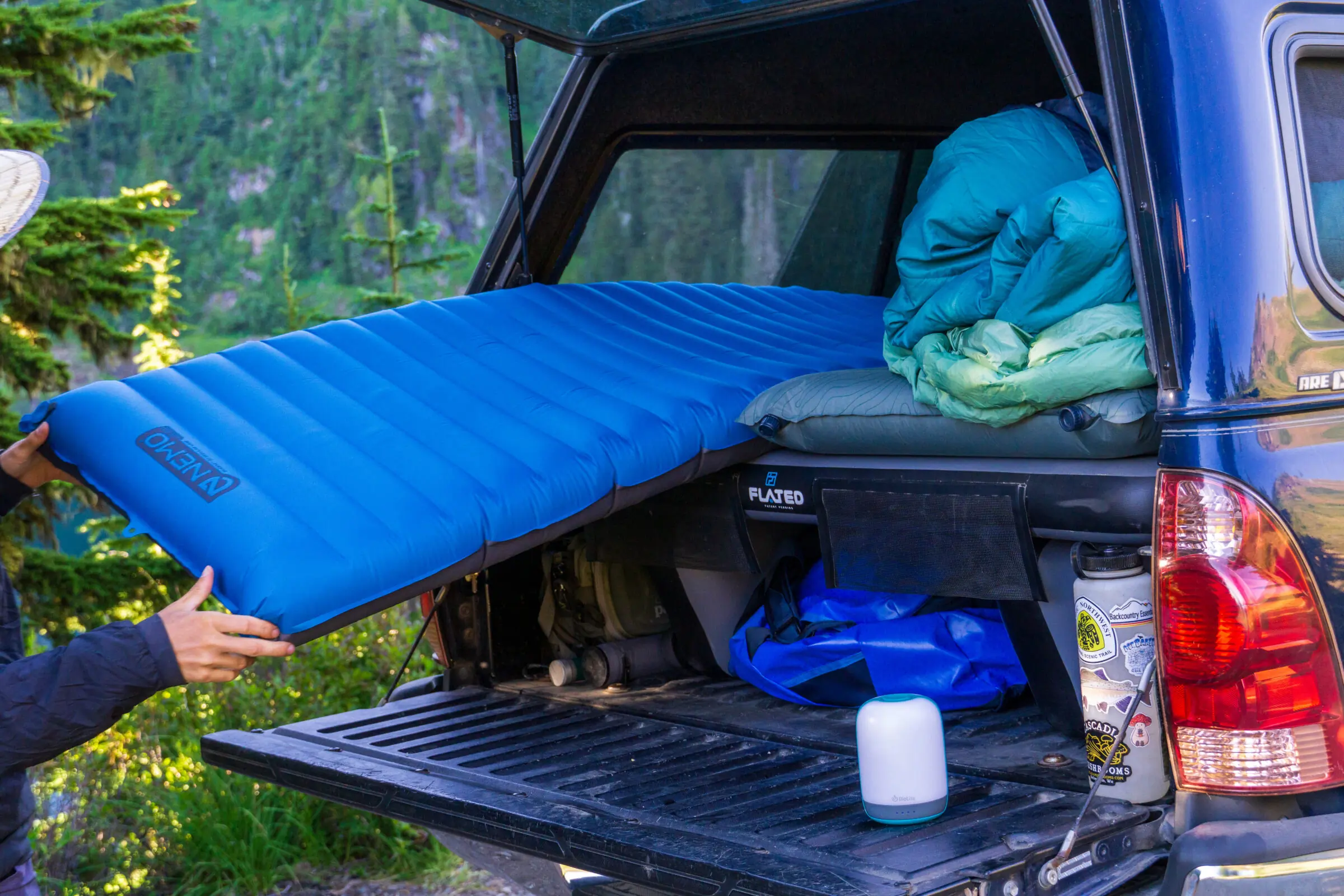



Our Sleeping Pad Rating System
I’ve identified four rating metrics that are the most important to consider when comparing camping mattresses. The combination of these scores forms the overall rating and can lend some insight into the strengths and weaknesses of these sleeping pads.
Comfort
Comfort reigns in camping mattress rating, and it’s the metric I weigh the most when considering a sleeping pad. Our team cycles these pads to different team members to get a relative score across several body types.
R-Value
The R-value of a camp mattress is a tested number that relates to warmth, with a higher number equating to greater heat retention. I look for a solid R-value of 4+ to award a high rating here, with pads over 7 gaining the highest scores.
Durability
Durability over the long term is important. I look for how the pad material holds up (top and bottom) and how the valves function after a full summer of use. A popped pad isn’t the end of the road, but it does result in a good score ding.
Weight & Packability
Because frontcountry camping doesn’t often require hiking too far, I rate weight and packability lower than other metrics when forming an overall score. However, I still look for a pad that can be compressed well for storage and transport and doesn’t weigh so much that kids can’t help move into the tent for the weekend.
Buyer’s Guide: How to Choose the Best Camping Mattress
Before reading our buyer’s guide, take a few moments to think about how you plan to camp and sleep.
Will you be driving up to a camp spot, sleeping in your vehicle, hiking a mile or so in, or heading out on a weeklong backpacking trip? Do you sleep on your back, side, or stomach? Is extra cushioning important, or do you care more about saving weight?
Understanding your sleep preferences will help determine the best camping mattress for you. Read on for the most important factors in choosing a camping pad. For this particular roundup, I focused specifically on pads made for car camping and similar applications. We did not test pads or mattresses designed to fit into a backpacking pack. If you’re looking for a backpacking pad, check out our favorite products here.


Camping Mattress Types
Self-Inflating: Laid up with a hybrid air/foam construction, a self-inflating camp mattress is filled with open-cell foam that can be compressed and expanded with the turn of the valve. Once open, air fills the chamber and expands the mat to its full volume, with all of the benefits of the added cushion of foam.
This foam does make these mats a good bit less packable and heavier, but for most campers who don’t have very far to travel, a self-inflating mattress makes the most sense. Consider the Therm-a-Rest MondoKing 3D as the standard bearer for self-inflating mattresses.
Foam Pads: Large and in charge, all foam mattresses are made with different densities of polyfoam to support and cradle you as you sleep — just flop it down and you’re good to go. While most foam mattresses today, like the Therm-A-Rest Z-Lite or NEMO Switchback, are oriented more for backpacking, there are others still that bulk up on the foam and forgo the portability in favor of comfort.
The greatest benefit of a foam mattress lies in its simplicity and ease of use, along with the guarantee that it won’t pop when in contact with any errant pokies. The HEST Dually was the only all-foam design to gain high marks from our testing, but it did so with ease.
Air Mattresses: The most simple of all camping mattress designs, air mattresses are completely suspended by the volume of air they trap. This means that you’ll need to inflate them, either courtesy of your lungs, or with a pump sack or electric air pump. The payoff for your effort comes in the form of packed volume, which is often much more compact compared to their self-inflating and foam counterparts.
On the car-camping side of the spectrum, the ALPS Mountaineering Vertex Air Bed goes up easy, and if you need a sleeping pad that can do it all, the Therm-a-Rest NeoAir Topo Luxe or NEMO Quasar 3D are both equally at home in a backpacking pack or the back of your truck.
Camping Mattresses vs. Sleeping Pads
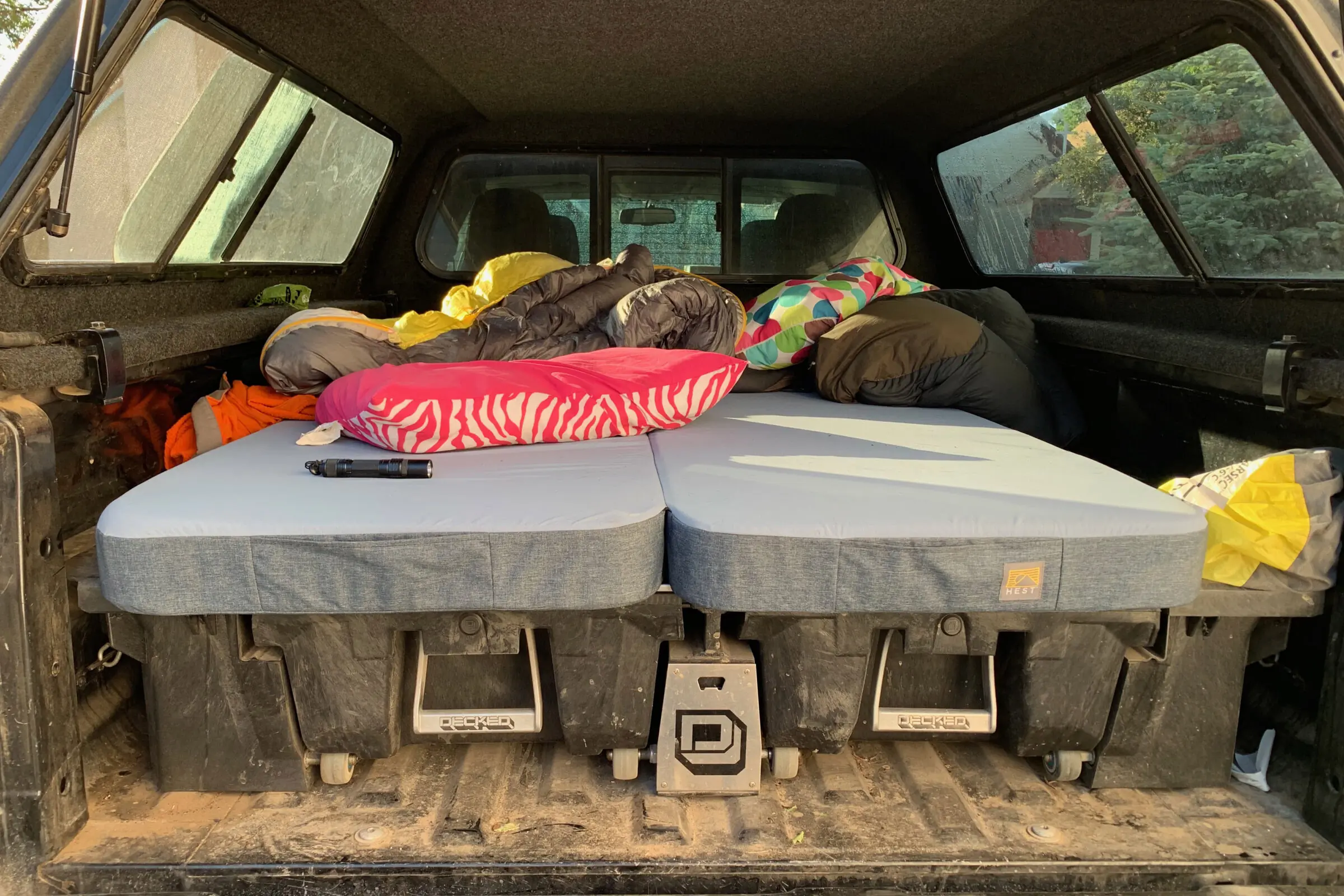



The difference between a camping mattress and a sleeping pad is a gray area. Consider the terms to exist on a continuum, with sleeping pads being more of your standard backpacking fare and prioritizing compressibility, and mattresses being thicker, cushier, and less portable.
These mattresses also very often incorporate more foam in their builds, and this can be a sure sign that a mattress prioritizes comfort over all else. At 32 pounds, the HEST Dually is definitely in the “mattress” category.
Sleeping pads are relatively thin, light, and portable. Though this list mostly focuses on car camping products, certain camping mattresses are portable enough to bring along on river trips and short backpacking missions. The Sea to Summit Comfort Deluxe is a prime example of a versatile sleeping pad.
Then, there are some options that buck convention and exist comfortably in between titles. A pad like the Therm-a-Rest NeoAir Topo Luxe is relatively thick at 4 inches, but due to its full air-pad design, it compresses down to a size that rivals many through-and-through backpacking pads.
Weight & Packed Size
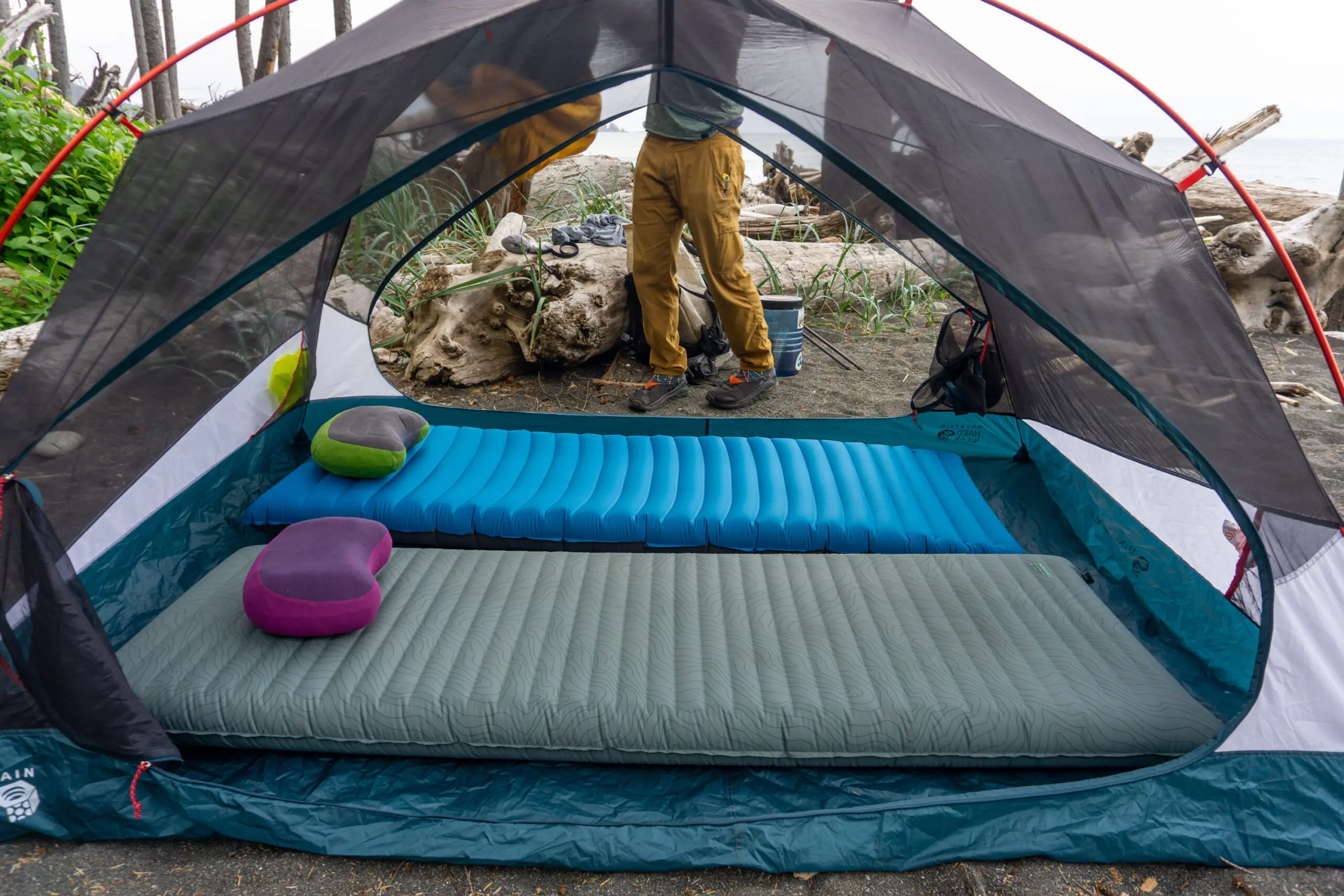



If you’re mainly car camping, you can maximize comfort by going with a more padded, inflatable option like the NEMO Roamer or a deluxe foam mattress like the HEST Dually. The tradeoff is that these don’t pack down as small and are too heavy for backpacking.
If you plan on hiking into the backcountry, a pad that packs down small and weighs less is ideal. Just how small and light you want to go is up to you. The Therm-a-Rest NeoAir Topo Luxe packs down to the size of a Nalgene bottle and weighs just 1 pound, 7 ounces.
Consider also how you’re going to be transporting your camping mattresses around. Many manufacturers today are getting wise to the issues caused by tube-style stuff sacks, which, while they may work the first time, good luck returning a mat to its nylon sleeve after you’ve used it. Many camping mattresses today come with side-opening stuff sacks, which feature a wide mouth for easy storage, as well as compression straps to cinch down the whole affair for easy transport.
Camping Mattress Comfort
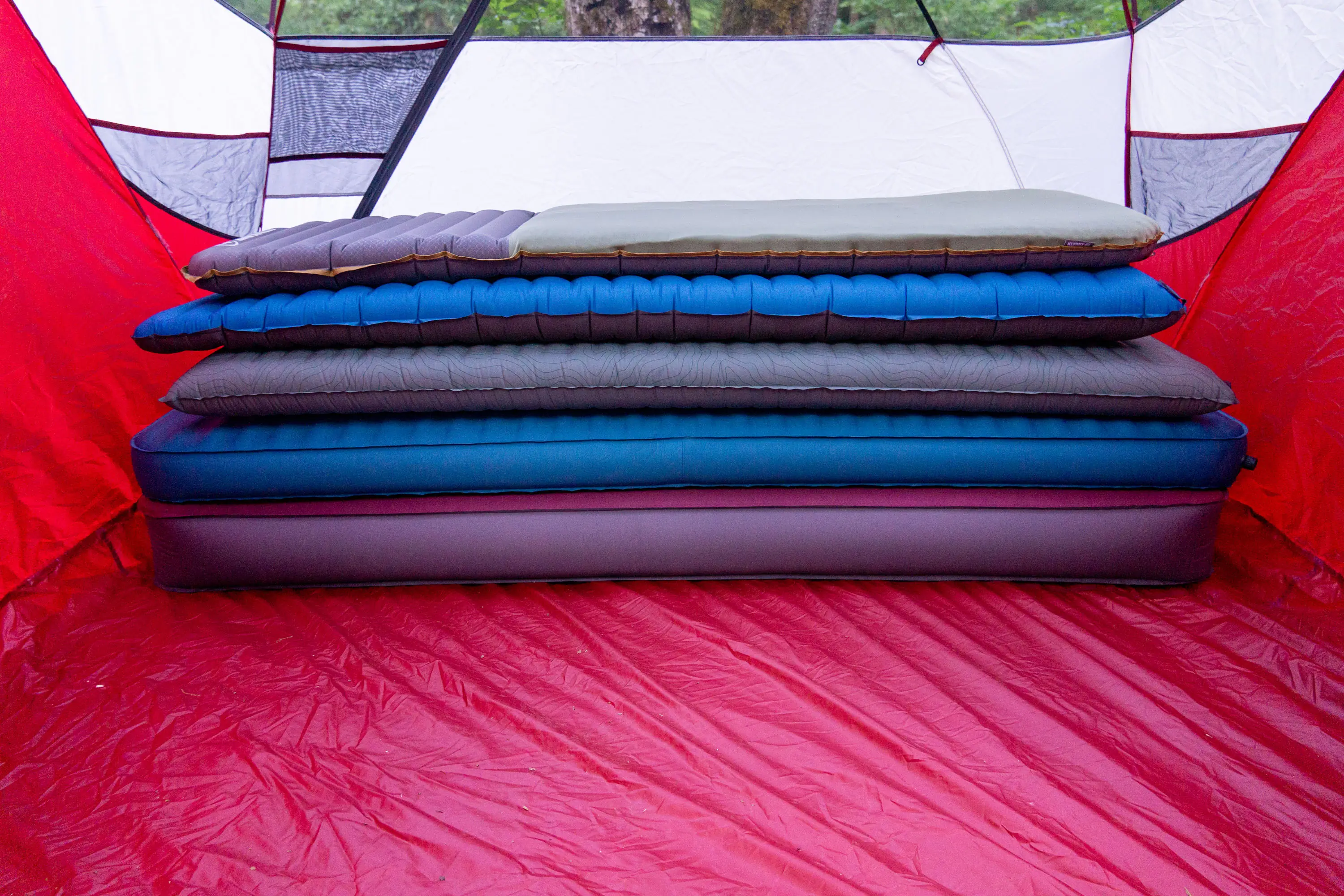



In general, the thicker the pad, the more comfortable it is. Additionally, having a bit of foam or extra insulation increases the comfort factor and decreases the noise (see below).
Since camping mattresses don’t need to often be carried far, they can afford to bump up the thickness in many cases. The average thickness across the pads we tested was 4 inches, with the thinnest of the bunch being the REI Co-op Campwell Sleeping Pad at 2.5 inches and the thickest being the luxurious EXPED MegaMat 15 Max at 6 inches.
Pads that rely on air alone for their structure can sometimes feel a bit bouncy if underinflated, which is why many will incorporate closed-cell foam in their construction. This gives the pad a self-inflating quality as the foam bounces back.
I have found through testing that around 3 inches is about the minimum I’m comfortable sleeping on a mattress that features no foam at all — while a mattress with foam has the ability to keep me comfortable down to below this thickness.
If you’re a side sleeper, you understand the need for plenty of cushioning under your hips and shoulders. For a better night’s sleep, you’ll want to consider a thicker option.
Durability & Denier


Denier is a unit of measurement used to describe textile strength. The higher the denier, the thicker and stronger the fabric. When it comes to mattresses and sleeping pads, this is mainly important for puncture resistance.
On one end, the lightweight and packable Therm-a-Rest NeoAir Topo Luxe is made with 50-denier nylon. On the other end, consider that the NEMO Roamer is made with 75-denier polyester. As you can imagine, there’s often a tradeoff between durability, weight, and packability.
Consider also the durability of the components used elsewhere in the pad, such as the interior closed-cell foam, or the inflation valves. As in most things, the maxim of getting what you pay for applies here as well. We have used certain sleeping pads for entire thru-hikes and have been impressed by their tenacity and ability to shoulder abuse. As always, take care of your equipment, and it will pay dividends in longevity.
Repairing your camp mattress can be a stressful endeavor, but being prepared for the situation can greatly alleviate that. Many pads today will ship with a small patch kit, which can be utilized in the field to repair small leaks. For more serious issues, consider a more total solution like the Therm-a-Rest Permanent Home Repair Kit, which has a long-cure epoxy and fabric patches. Even certain valves today are user-replaceable.
Warmth & R-Value
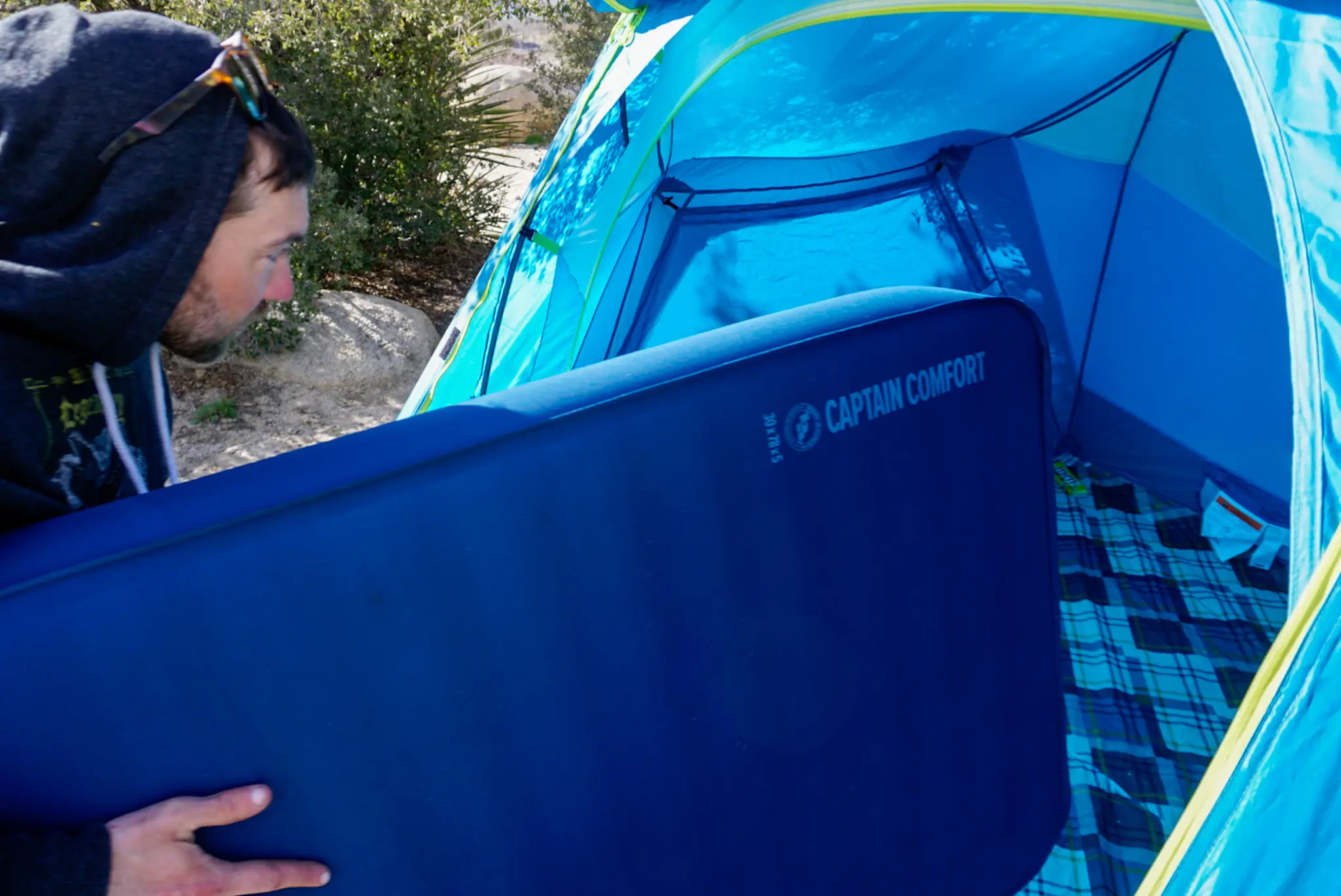



In addition to comfortable cushioning, a good camping pad should provide some insulation from the ground. Enter the R-value: a measure of thermal resistance that can shed some light on just how warm a camping mattress might keep you.
R-value testing goes a little like this: inside a cold chamber, a mattress or pad is placed between two metal plates. An array of sensors measures the temperature flow between these plates and provides a numerical value relative to the mattress or pad’s ability to retain and reflect warmth.
Since testing can occur in different ways, many sleeping pad manufacturers have adopted the ASTM (American Society for Testing and Materials) R-value Standard. The higher the R-value, the warmer and more insulating the sleeping pad will be. Notably, the MegaMat and Big Agnes Captain Comfort clock in with whopping 9.5 and 8.3 R-values, respectively, making them both cozy for year-round car camping.
The R-value you need depends a bit on whether you tend to be a warm or cool sleeper, as well as the specific sleeping bag that you’ll be using. In general, you’ll want a mattress or pad with a value greater than 5 for comfortable winter camping. For summer, something in the 2 to 4 range should work for warmer nights.
Length & Width
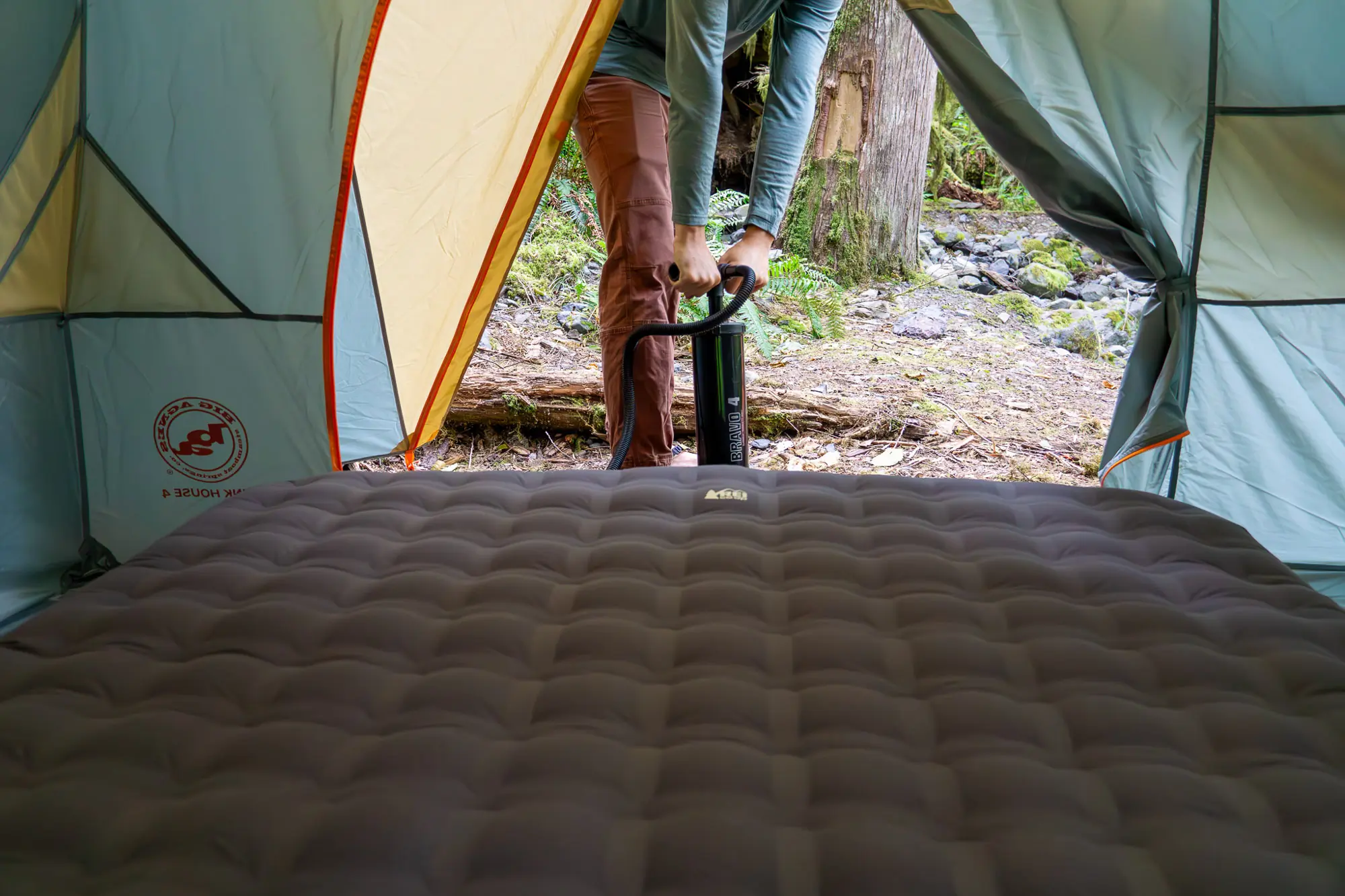



Most camping mattresses come in regular and long versions. Some also come in short, wide, and extra-long varieties. The length and width you need depend not only on your dimensions but also on your camping goals. The pad you go with will also ultimately depend on the space that’s available to you to sleep in. Consider that typical backpacking tents more often have more space-efficient floor plans, while camping tents will provide more space for larger camping mattresses.
I’ve found that while backpacking sleeping pads begin at around 20 inches wide, many camping pads start at around 25 inches and expand from there. And while mummy-style profiles are popular in backpacking pads, most camping mattresses will afford the extra comfort and space that comes with a true rectangle design.
Valves & Inflation


Up until recent years, almost all camping mattresses and sleeping pads utilized a twisting plastic valve. Turn one direction to open it for inflation, and (quickly!) turn the other to close and trap air inside.
While this system works, it’s not the easiest to inflate. Because air can freely move back and forth, you need to either create constant pressure while blowing it up or skillfully use your tongue to stop air from exiting the pad while inhaling. It can be done, but we prefer the new inflation technology when tired on the trail.
Luckily, many mattresses and pads now use flat valves with dedicated inflation and deflation settings. Best of all, a one-way flap keeps air from escaping during inflation.
While many pads feature separate valves for inflation and deflation, the Klymit Insulated Klymaloft has a valve that flips from one mode to the next. This makes achieving the perfect firmness possible, but these valves aren’t our favorite for the finnicky-factor.
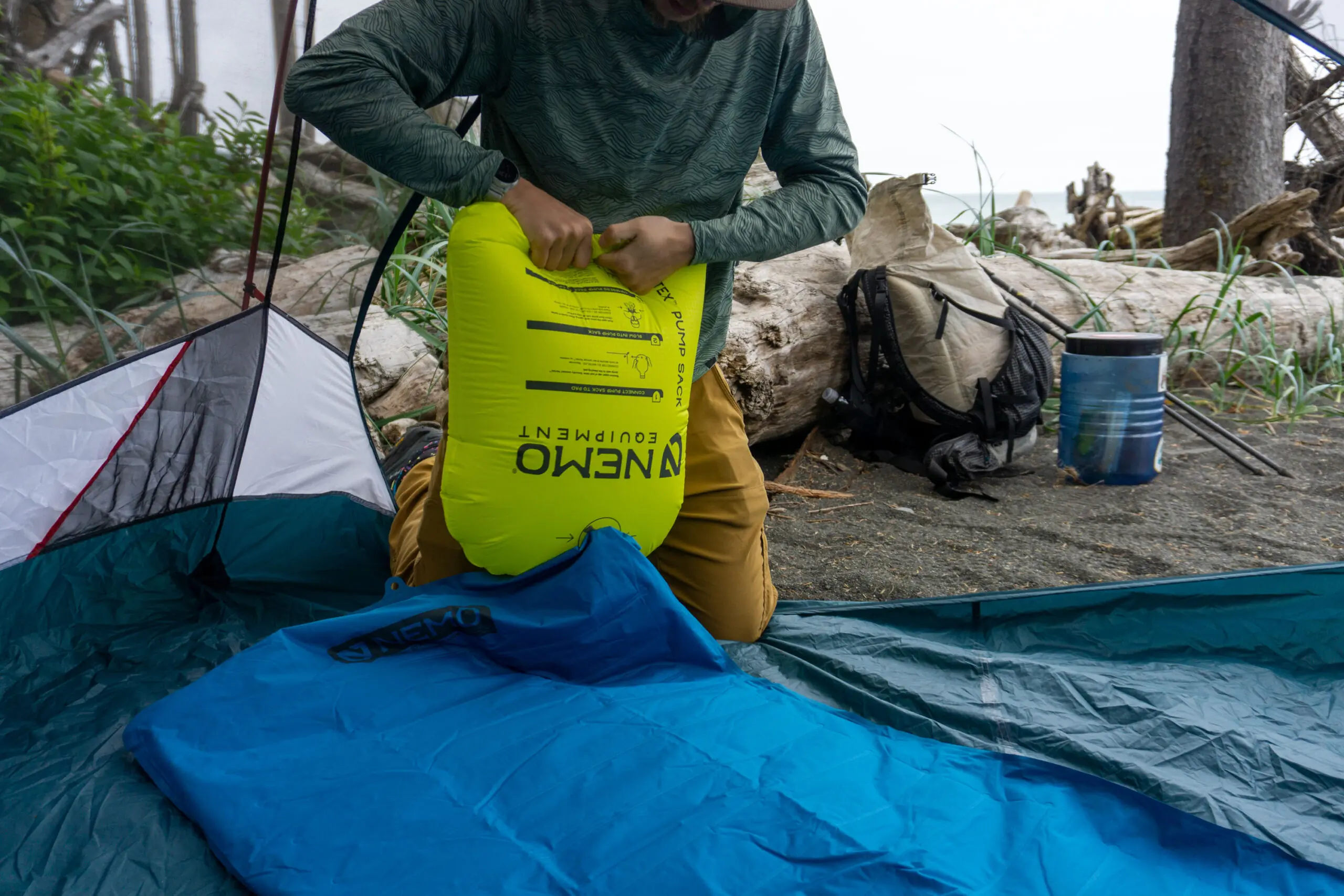



In addition to valves, many pads now come with inflation bags. The Therm-a-Rest MondoKing 3D comes with an inflation bag integrated into the stuff sack. The Big Agnes Pumphouse Ultra ($35) is sold separately and works as both a dry bag and an inflation bag. Utilizing these pump sacks has multiple benefits, and they are easy to use once you get the hang of them.
Begin by attaching the sack to the valve of your mattress or sleeping pad, and then expand the bag so that it fills with air. We often find that a light breath will expand the bag quickly. Then, close off the opening and compress the bag so that it forces the trapped air into the pad.
The upside to this system is not only speedy inflation but also that no moisture from your warm breath enters the sleeping pad. At its most benign, warm air will contract overnight and lead to a saggy mattress, but there are also concerns of mildew to be mindful of.
Finally, many manufacturers are now coming out with diminutive electric air pumps to assist in getting your sleeping pad up and running. These include the EXPED Widget, the Klymit USB Rechargeable Pump, and the Therm-a-Rest NeoAir Micro Pump ($43). Bringing these along may seem trivial at the trailhead, but after a long romp in, we’ve happily borrowed many to get our camp set up quickly.
Self-Inflating
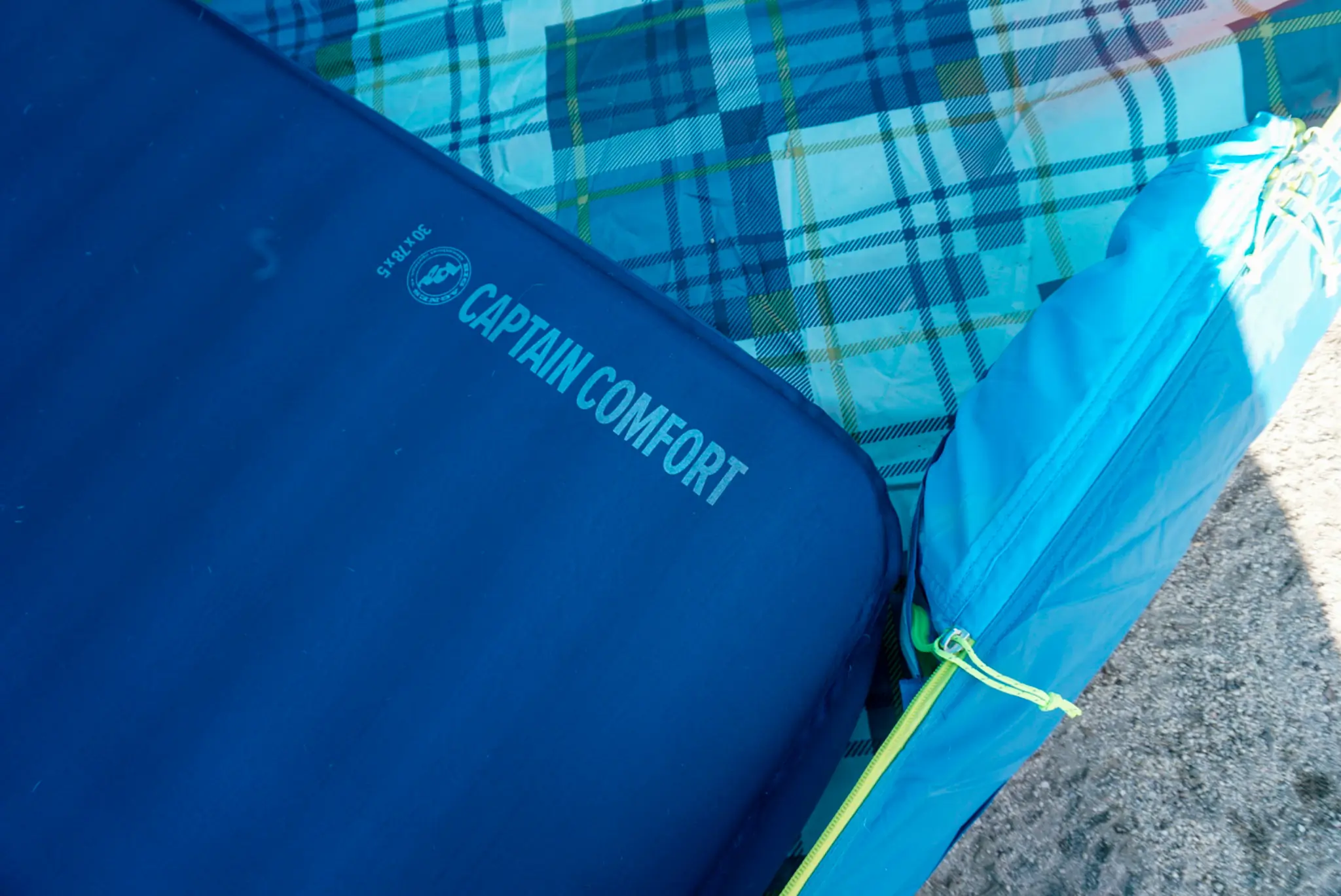



Self-inflating, also abbreviated as ‘SI,’ pads have been around the block for a number of years, and rely on a foam interior to rebound to their original dimensions to inflate the mattress. We have found that given enough time, these generally will get about 75% of the way to fully inflated, and will require a quick few breaths or pumps from a pump sack to fully inflate the pad.
Consider tossing your self-inflating mattresses into your tent early on in your camp setup to better ensure that it has enough time to fully reconstitute themselves. It’s also worth noting that these mattresses are less susceptible to cold contraction overnight, as the air they are filled with is ambient temperature, versus the warm air from your lungs.
Noise


The most common complaint about camping sleeping pads is the loud, crinkly noise. While packing less is great, sleeping on a pad as noisy as a potato chip bag is less than ideal. And having your tentmate toss and turn all night is even worse.
Fortunately, brands are taking note and making quieter sleeping pads. On this list, the EXPED MegaMat is noticeably crinkle-free. This is largely due to the inclusion of foam in the build, and any pad that utilizes it will see a definite reduction in noise overall.
Price & Value
We love a good value. But even more than that, we appreciate gear that performs well and lasts through several seasons of use. They say you should never compromise when it comes to things that connect you to the ground, and besides tires and shoes, mattresses are up there. That said, there’s a spectrum of worth to consider when making your purchase, and even budget pads these days are comfy enough to enjoy all weekend long.
Budget
If you only plan to sleep outside a weekend or two a year, a cheaper pad may get the job done just fine. Less material means less price, which means that budget sleeping pads will be thinner than pricier options, more often 2.5 to 3 inches thick. These pads will also often not use a vertical sidewall design, meaning your sleeping area will be a bit smaller. Expect to pay between $100 and $180 for these mattresses.
At just above $119, the REI Co-op Campwell Sleeping Pad is an impressive value, but it certainly won’t be winning any awards for absolute luxury. That’s why we suggest bumping up the extra $60 in order to get into the REI Co-op Camp Dreamer XL, an outlier at 4″ thick and vertical sidewalls that punches well above its weight.
Mid-Tier
We find that pads and mattresses in the $250-300 range are about the sweet spot when it comes to balancing price and features. These are most often around 4″ thick and feature self-inflating foam and air constructions. You tend to also get dual valve designs that will both hold air as you’re inflating, as well as when you’re deflating, making set up and packing a breeze. Different sizing options also exist in this price range, with wide and double versions available.
Our favorite all-arounder is still the Therm-a-Rest MondoKing 3D ($240), a 4.25″ thick pad with plenty of cushion to air down a bit and really sink in for a night of sleep. The NEMO Roamer ($250) is similarly a standby (with slightly less nice valves), along with the Sea to Summit Camp Deluxe ($249) — a great option for anyone looking to fill out their camp mattress stable.
Premium
Toward the upper end of the spectrum are the luxuriously thick and warm pads, such as the EXPED MegaMat Duo 10 and MegaMat 15 Max. These pads both will put a bigger hurting on your wallet at $300+, but offer up incredible comfort in return. The price increase on the Duo comes from the added space, while the MegaMat Max owes it to the 6 whole inches of insulation beneath you.
This is the foundation of your sleep, and getting enough rest at night will make spending all day outside that much more enjoyable. In general, forking over a few extra bucks will get you some combination of increased comfort, durability, and warmth.
Frequently Asked Questions
We find that camping mattress comfort is very often directly tied to overall thickness, as well as the inclusion of foam in the build. Because of this, hybrid-style designs such as the NEMO Roamer or EXPED MegaMat Duo 10 will always be high on our lists of the most comfortable.
If price and weight are no concern, the HEST Dually is a unique foam mattress that provides top-tier comfort. For a more packable camp mattress, the Therm-a-Rest MondoKing is a winner.
This depends entirely on your individual comfort level. Generally, we’d recommend 1.5 inches as the bare minimum.
And if price and space are not a concern, go with something in the range of 4+ inches. This not only offers increased padding, but also greater warmth and protection from the ground. If a camping mattress is purely suspended by air alone, it will need to be thicker than designs that use air and foam together to support your body.
Finding the right camping mattress can make or break your camp trip. First consider, where, when, and how often you plan to camp.
Are you camping in the hot, humid South? Or do you camp a lot in the winter? And are you spending a lot of time outside or just getting started with a night or two camped out?
If you’re camping when it’s cold, you’ll want to prioritize a higher insulation (R-value) level. And if you’re just testing it out or on a tighter budget, go with something like the sub-$120 REI Co-op Campwell Sleeping Pad.
The best thing about car camping is that you don’t need to obsess over the weight or packed size. As long as it reasonably fits in your car, you can focus more on comfort.
After more than a year of testing, we found the Therm-a-Rest MondoKing topped the charts for durability, comfort, and ease of use. If you’re looking for a foam mattress, the HEST Dually delivers traditional comfort that will never let you down overnight.
The R-value, generally speaking, is a measure of the ability of a camping mattress to resist heat transfer. Because a mattress or sleeping pad is such a vital part of your camping sleep system, it’s important to match your pad and sleeping bag for the overnight temperatures you’ll be anticipating.
The higher the R-value of your mattress or sleeping pad, the greater it will resist giving away your hard-earned body heat to the ground beneath it. R-values in backpacking pads typically range from 1 to 6, while camping mattresses are often warmer, and can sometimes reach double digits. For 3-season camping, consider a mattress or pad with an R-value of between 1 and 4, and for shoulder season or winter camping, you’ll want a pad with a value greater than 5.
It’s important to note that this rating system has only recently become standardized, and is now set in place by the international regulating agency ASTM International. This levels the playing field when it comes to comparing different products.
When it comes to side sleeping, having a thicker camp mattress can make or break your overnight experience. Throughout our testing, we have found 3 and 4 inches of cushion to be about perfect for ensuring that our hip bones don’t come in contact with the ground.
It’s important to note that mattresses that utilize a foam and air construction often support side sleepers better than pads that are only supported by air. This is because the foam helps to spread out the pressure points caused by side sleeping. Side sleepers should consider a mattress like the Therm-a-Rest LuxuryMap, which has body-mapped foam to better support the hips during sleep.
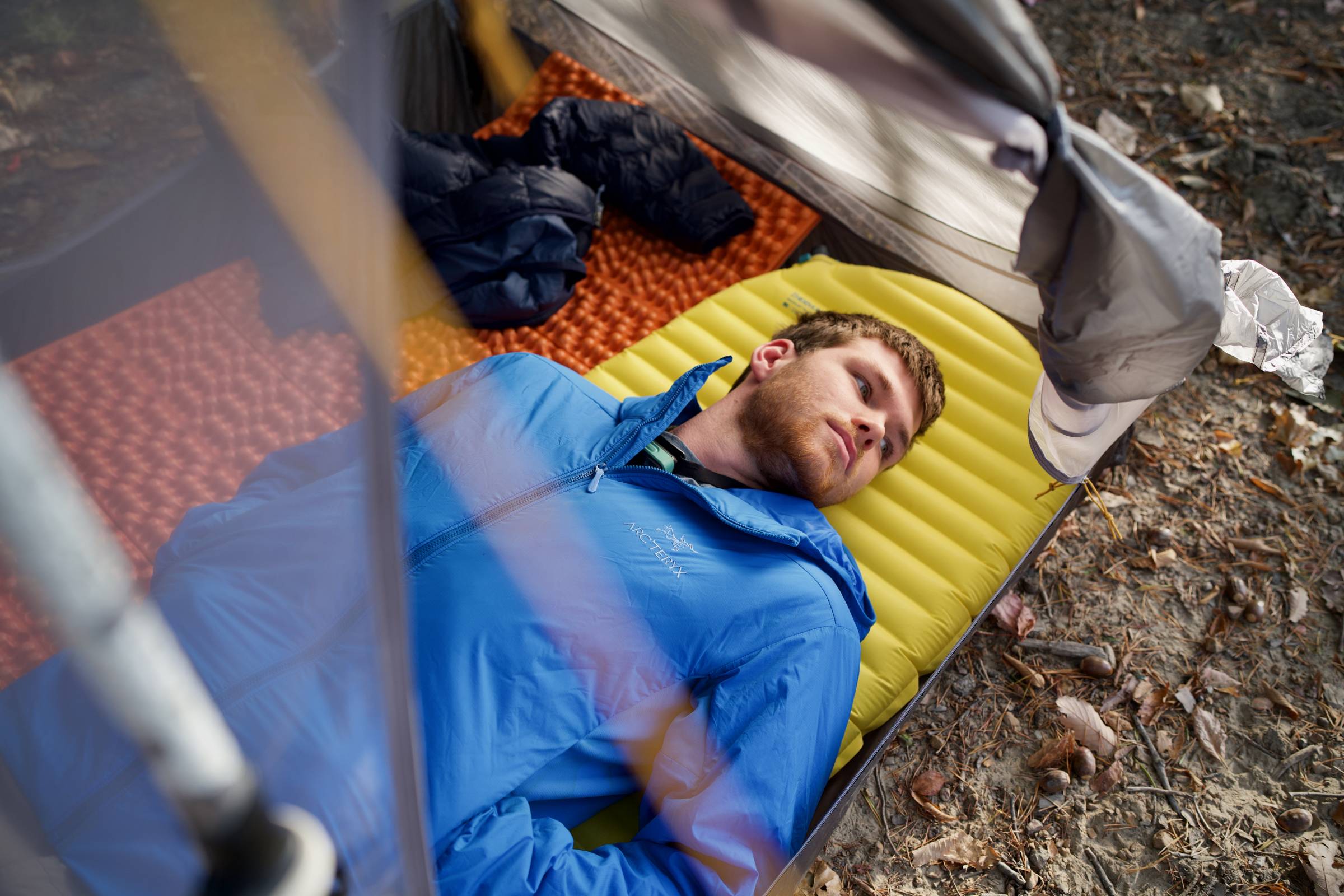

The Best Backpacking Sleeping Pads of 2025
We tested and reviewed the best sleeping pads for backpacking in 2025. Whether you need an ultralight mat or more insulation, we’ve got it.
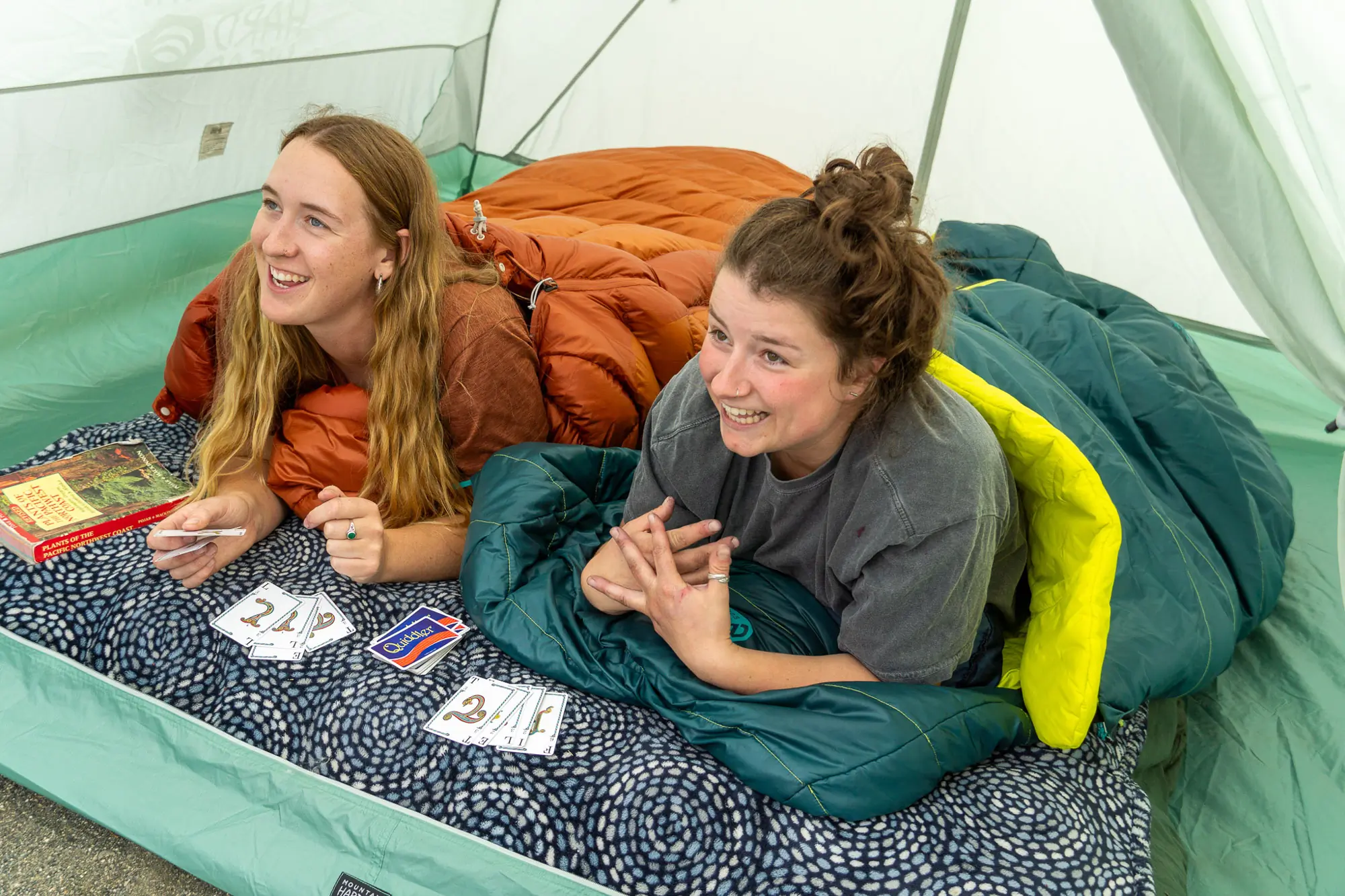

The Best Camping Sleeping Bags of 2025
From versatile camping bags to wallet-friendly picks, we’ve found the best sleeping bags for every use and budget.


